Kingdom Systems of Classification
- Books Name
- ACME SMART COACHING Biology Book
- Publication
- ACME SMART PUBLICATION
- Course
- CBSE Class 11
- Subject
- Biology
KINGDOM SYSTEMS OF CLASSIFICATION
(1) Two Kingdom Classification: It was given by Linnaeus. Traditionally all the organisms of the world were divided into two kingdoms -the animal kingdom (Animalia) and the plant kingdom (Plantae). The major criterion of classification was the presence or absence of cell wall. Other criterias were locomotion, mode of nutrition, response to external stimuli etc
Concept Builder
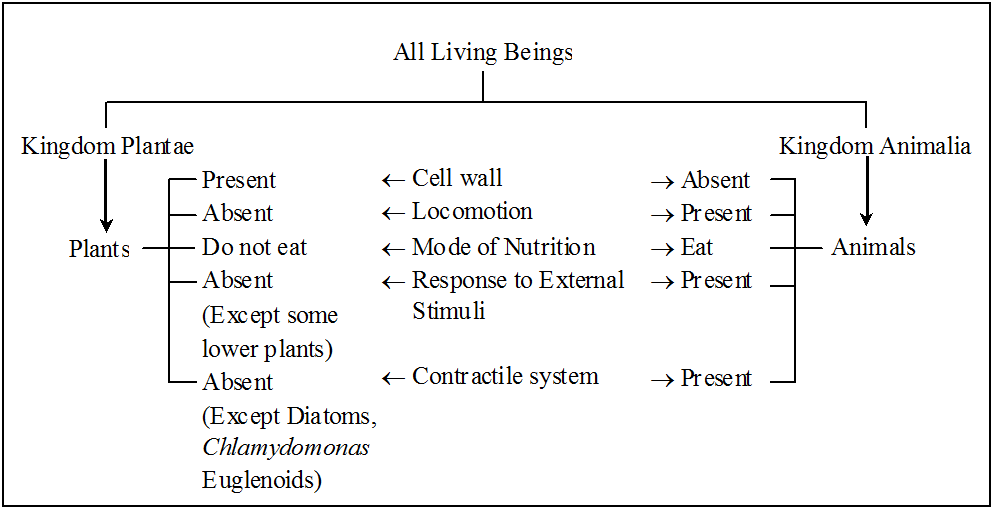
Shortcomings of two-kingdom system of classification:
This system did not distinguish between the eukaryotes and prokaryotes, unicelled and multicelled organisms, photosynthetic and non-photosynthetic organisms.
There are few organisms like Chlamydomonas, Euglena and the slime moulds which have been claimed by both zoologists and botanists (organisms which share characteristics of both animals and plants).
Since there are certain organisms that do not fall naturally into either plant or animal kingdom, it was proposed that a new kingdom is to be established to accommodate such organisms.
(2) Three Kingdom Classification:
Haeckel, a German zoologist (1866), suggested that a third kingdom Protista, be created to include all unicellular microorganisms.
This includes a wide variety of unicellular, mostly aquatic eukaryotes like -Fungi, Protozoa, Algae, Bacteria and Slime moulds.
Thus, he proposed three kingdoms, namely -Plantae, Protista and Animalia.
(3) Four Kingdom Classification:
Copeland (1956) gave four kingdom of classification and included Monera as fourth kingdom.
Copeland originally called it as kingdom 'Mychota'.
It was called 'Monera' by Daugherty and Allen.
Kingdom Monera includes all the prokaryotic organisms i.e., eubacteria (including cyanobacteria, formerly known as blue-green algae) and archaebacteria.
The actinomycetes (filamentous bacteria) are also included in this kingdom.
(4) Five Kingdom Classification:
According to five-kingdom concept proposed by R.H. Whittaker.
Whittaker (1969), the organisms are divided into five kingdoms namely Monera, Protista, Fungi, Plantae, Animalia, on the basis of the following criteria
(a) Complexity of cell structure: prokaryotic vs eukaryotic organisation of cells.
(b) Complexity of body organisation: unicellularity vs multicellularity; simple multicellular forms to complex multicellular forms.
(c) Mode of nutrition: Autotrophic vs heterotrophic (parasitic or saprobic or ingestive organisms). It was the major criteria of this classification system.
(d) Reproduction.
(e) Phylogenetic or evolutionary interrelations
Table 1 : Comparative account of different characteristics of the Five Kingdoms
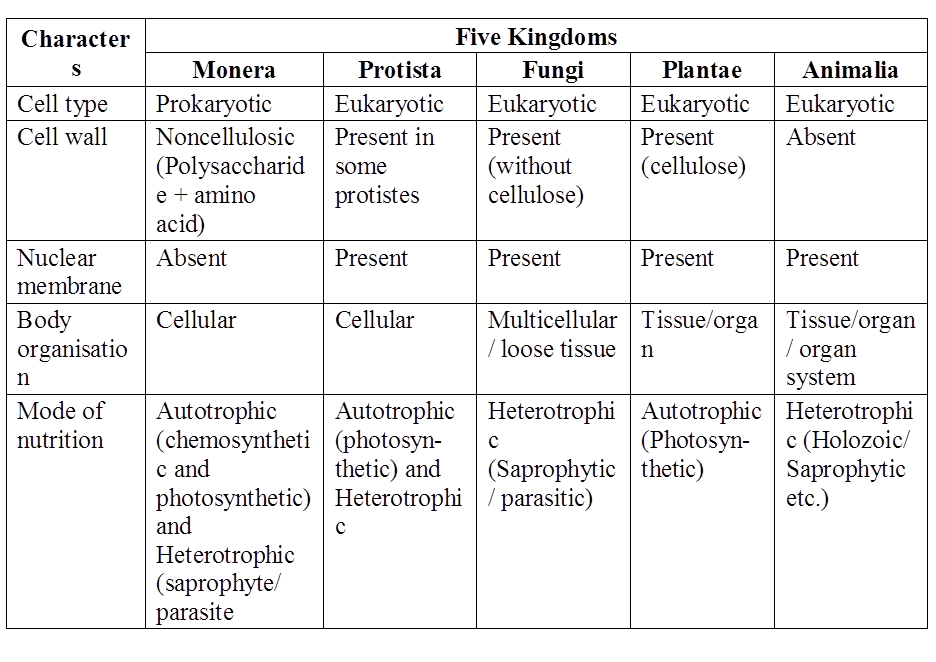
(5) Six Kingdom Classification :
Carl Woese proposed six kingdom classification.
These six kingdoms are Archaebacteria, Eubacteria, Protista, Fungi, Plantae and Animalia.
He separated the archaebacteria from eubacteria on the basis of some major differences such as the absence of peptidoglycan in the cell walls of the former and the occurrence of branched chain lipids (a monolayer instead of a phospholipid bilayer) in the membrane.
Based on the sequence of 16S ribosomal RNA genes, Woese found that the six kingdoms naturally cluster into three main categories.
He called these categories as domains of life.
These domains are Bacteria, Archae and Eukarya and are believed to have originated from common ancestor called progenote.
Three Domains of life
Based on the sequence of 16 S ribosomal RNA genes, woese found that the six kingdoms naturally cluster into three domains.
These domains are Archae, Bacteria and Eukarya, and are believed to be originated from common ancestor called Progenate. Domain is a category higher than kingdom.

Kingdom Systems of Classification
Chapter 2
Biological Classification
Biological classification is the practice of categorizing living and extinct organisms into groups based on shared traits. Classifying organisms is necessary because it allows us to better understand biodiversity. It aids in the identification of living entities as well as the comprehension of their diversity. Classification aids in our understanding of different types of plants and animals and their characteristics, similarities, and differences. It allows us to see how complex organisms develop from simpler organisms. Different categories are used to understand and research the characteristics, similarities, and differences among various living species. Classification is the tool that allows us to manage a wide range of living organisms. Understanding the inter-relationships between different groups of organisms is critical. Other biological sciences are built on the foundation of classification.
Kingdom Systems of Classification:
Aristotle was the first to attempt to classify things on a more scientific basis. He classified plants into trees, shrubs, and herbs based on simple physical characteristics. He also separated the animals into two groups: those with red blood and those without. A Two Kingdom system of classification was devised during Linnaeus's time, with Plantae and Animalia kingdoms encompassing all plants and animals, respectively. Eukaryotes and prokaryotes, unicellular and multicellular organisms, photosynthetic (green algae), and non-photosynthetic (fungi) species were all lumped together in this system. Plant and animal classifications were simple to implement and understand, but a huge number of creatures did not fit into either group. As a result, the long-used two-kingdom classification was determined to be inadequate. Aside from gross appearance, there was a need to include other characteristics such as cell structure, wall nature, manner of nourishment, habitat, reproduction strategies, evolutionary linkages, and so on. As a result, classification systems for living organisms have experienced several alterations over time. Though the plant and animal kingdoms have remained consistent throughout all systems, the understanding of which groups/organisms should be included inside these kingdoms has evolved; the number and character of additional kingdoms have also been interpreted differently over time by different scientists.
A Five Kingdom Classification was proposed by R.H. Whittaker in 1969. Monera, Protista, Fungi, Plantae, and Animalia were the kingdoms he defined. Cell structure, body arrangement, manner of nourishment, reproduction, and phylogenetic links are among his key classification criteria. A three-domain approach has also been proposed, which divides Kingdom Monera into two domains and leaves the remaining eukaryotic kingdoms in the third domain, resulting in a six-kingdom categorization.
Let's take a look at this five-kingdom classification to see what concerns and considerations affected the system. Plants included bacteria, blue-green algae, fungi, mosses, ferns, gymnosperms, and angiosperms in previous classification systems. The fact that all of the species in this kingdom had a cell wall in their cells served as a unifying characteristic. This grouped people who had a lot of things in common but also had a lot of things in common. It brought together prokaryotic bacteria and blue-green algae (cyanobacteria), as well as other eukaryotic species. It also combined unicellular and multicellular species together, such as Chlamydomonas and Spirogyra being categorized together under algae.The classification did not distinguish between the heterotrophic fungus and the autotrophic green plants, albeit they did have a distinct difference in the composition of their cell walls, with the fungi having chitin and the green plants having a cellulose cell wall. When these qualities were taken into account, the fungi were given their own kingdom: Kingdom Fungi. Kingdom Monera was created to unite all prokaryotic species together, while Kingdom Protista was created to group all unicellular eukaryotic organisms together. Chlamydomonasand Chlorella (both of which have cell walls and were previously put in Algae within Plants) have been combined with Paramoecium and Amoeba in the kingdom Protista (which were earlier placed in the animal kingdom which lack cell walls). It has brought together organisms that were previously classified into various kingdoms.
Kingdom: Monera
- Books Name
- ACME SMART COACHING Biology Book
- Publication
- ACME SMART PUBLICATION
- Course
- CBSE Class 11
- Subject
- Biology
KINGDOM: MONERA
The Kingdom Monera includes all prokaryotes.
Monerans are the most primitive forms of life, originating from more ancient living stock termed progenote.
The kingdom Monera includes eubacteria and archaebacteria.
Eubacteria includes Cyanobacteria, Actinomycetes, Mycoplasma, Rickettsiae, Chlamydiae and Spirochaetes etc.
Classification of Monera
(1) In 4 kingdom system, a new kingdom was created to accommodate all prokaryotic organisms i.e, eubacteria and archaebacteria. Copeland called it kingdom Mychota. It was called 'Monera' by Daugherty and Allen.
(2) Actually, archaebacteria differ from eubacteria in many respects and resemble eukaryotes in some ways.
(3) (i) Carl Woese separated the archaebacteria from eubacteria on the basis of some major differences such as the absence of peptidoglycan in the cell walls of the former and the occurrence of branched chain lipids (a monolayer instead of a phospholipid bilayer) in the membrane.
(ii) Therefore, 6 kingdoms given by Carl Woese are
Kingdom-1 -Archaebacteria Kingdom-2 -Eubacteria
Kingdom-3 -Protista Kingdom-4 -Fungi
Kingdom-5 -Plantae Kingdom-6 -Animalia
Salient Features of Monera
1. These are unicellular, colonial, multicellular prokaryotic organisms without nuclear membrane, nucleolus, chromatin and histone proteins.
2. Cell wall is made up of peptidoglycan (exceptions are Archaebacteria and Mycoplasma).
3. Membrane bound organelles are absent.
4. Cyclosis is absent and ribosomes are of 70 S type .
5. Respiratory enzymes are found associated with plasma membrane.
6. Nucleoid or genophore or incipient nucleus or prochromosome is composed of naked DNA, RNA and nonhistone proteins.
7. Reproduction by asexual method.
8. Cell division is amitotic type and lacks spindle formation.
Let us discuss various monerans in detail :
1. EUBACTERIA
Bacteria are cosmopolitan and occur in every habitat wherever living or dead organic matter is present.
Anton Von Leeuwenhoek discovered bacteria in rain water which had been allowed to stand for many days and tartar scrapped from teeth.
In 1695, he published his work "The Secrets of Nature".
A.V. Leeuwenhoek termed these microorganisms as dierkens which was later translated as animalcules by the Royal society.
Term microbe for animalcules was coined by Se' dillot, but the term microorganism was proposed by Pasteur.
Concept Builder
Ehrenberg first of all coined the word 'bacteria'
Louis Pasteur is considered father of modern microbiology. He introduced the term aerobic and anaerobic for the life in the presence or absence of oxygen respectively.
Robert Koch, a German doctor, demonstrated that the anthrax disease of sheep was caused by bacteria. Koch had followed four experimental steps (Koch's postulates) which help to establish a relationship between a microorganism and a disease.
Smallest bacterium : Dialister pneumosintes
Largest filamentous bacterium : Beggiatoa mirabilis
Shapes of Bacteria
Bacteria occur in four basic forms or shapes.
These are spherical (Cocci), rod shaped (Bacilli), Vibrio and Spiral.
Though most bacterial species have cells that are of a fairly constant and characteristic shape, some species are pleomorphic (i.e., these can exhibit a variety of shapes), e.g., Rhizobium leguminosarum.
(a) Coccus : Spherical or nearly spherical, aflagellate, sub-divided into six groups on the basis of cell arrangement:
Monococcus -Only single cell represents the bacterium, e.g., Micrococcus luteus, M. roseus.
Diplococcus -Cocci divide in one plane and remain attached in pairs, e.g., Meningococcus, Gonococcus, Diplococcus pneumoniae.
Streptococcus -Cocci remain attached to form chains of different lengths, e.g., Streptococcus lactis.
Tetracoccus -Cocci divide in two planes at right angles to one another and form groups of four, e.g., Tetracoccus, Neisseria.
Staphylococcus -Cocci divide in several planes resulting in formation of irregular bunches of cells, sometimes resembling a cluster of grapes, e.g., Staphylococcus aureus.
Sarcinae -Cocci divide in 3 planes at right angles to one another and resemble cubical packets of 8 or more cells forming three dimensional geometrical figures, e.g., Sarcina lutea.
(b) Bacillus : Rod-like forms, either singly or may be arranged differently. They are generally flagellate. It is the most common of all the shapes. They are of following types :
(i) Monobacillus -The bacteria occur singly, e.g., Bacillus anthracis, Lactobacillus.
(ii) Diplobacillus -Bacteria are arranged in pairs. e.g., Bacillus subtilis
(iii) Streptobacillus -Bacteria form a chain of rods, e.g., Streptobacillus.
(iv) Palisade-like -If the cells are lined side by side like match sticks and at angles to one another.
e.g., Corynebacterium diphtheriae.

(c) Spiral bacteria : Coiled forms of bacteria exhibiting twists with one or more turns are called spirilla, e.g., Spirillum volutans.
(d) Vibrio : Bacteria with less than one complete twist or turn are called vibrio. These resemble a comma (,) in appearance, e.g., Vibrio cholerae.
(e) Stalked bacteria : The body of bacterium possesses a stalk, e.g., Caulobacter.
(f) Budding bacteria : The body is swollen at places, e.g., Rhodomicrobium
Bacterial Cell Structure
Bacterial cell structure is very simple although they are very complex in behaviour. They show the most extensive metabolic diversity. Electron microscope can only reveal the detailed structure of bacterial cell. It consists of following structures:
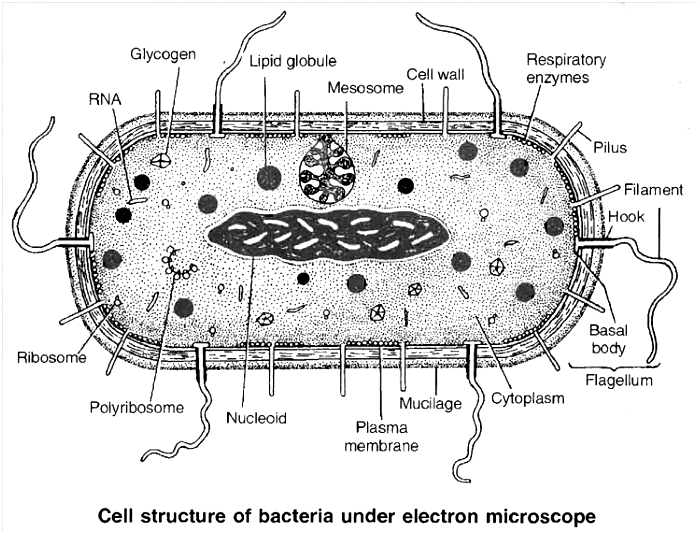
1. Glycocalyx:
(i) It is outermost part of cell envelope (Glycocalyx, cell wall, plasma membrane)
(ii) Represented by either slime layer or capsule
(a) Slime layer is composed of dextran, dextrin and lavan sugars and protect the cell against desiccation and loss of nutrients.
(b) Capsule is made up of polysaccharides and D-glutamic acid. It provides gummy or sticky character and virulent property to the cell.
2. Cell wall :
It is present outside the cell membrane and is a rigid structure.
Due to its rigidity, it protects the internal structures of the cell and provides shape to the cell.
However, its main function is to prevent the cell from expanding and bursting because most bacteria live in hypotonic environments, and are likely to take in much water and eventually burst.
The cell walls of almost all the eubacteria (true bacteria) are made up of peptidoglycan, also called murein or mucopeptide.
It is found only in prokaryotes.
As the name suggests, the peptidoglycan consists of two components-a peptide portion which is composed of amino acids connected by peptide linkages, and a glycan or sugar portion.
The glycan portion, which forms the backbone of peptidoglycan, is composed of alternating units of amino sugars N-acetyl-glucosamine (NAG) and N-acetylmuramic acid (NAM) joined together by b-1, 4 linkages.
The peptidoglycan chains are laterally linked by short chains of four amino acids which are attached to N-acetylmuramic acid residues.
The four amino acids of this tetrapeptide are D-alanine, L-alanine, D-glutamic acid and L-Iysine (in Gram +ve bacteria) or diaminopimelic acid (in Gram -ve bacteria).
The tetrapeptide chains are also interlinked by a peptide bridge between the carboxyl group of an amino acid in one tetrapeptide chain and amino group of an amino acid in another tetrapeptide chain.
The cross linkages can occur between tetrapeptides in different chains, as well as between adjacent tetrapeptide chains. As a result, peptidoglycan forms a rigid, multilayered sheet.
Another component, teichoic acid, an acidic polymer consisting of a carbohydrate (e.g., glucose), phosphate and an alcohol is found in cell walls of Gram +ve bacteria.
Teichoic acid has several functions such as binding metals, acting as receptor sites for some viruses and maintaining cells at low pH to prevent degradation of cell walls by self-produced enzymes.
The walls of Gram positive bacteria contain very little amount of lipids.
The cell walls of Gram negative bacteria are much more complex.
The peptidoglycan layer is very thin making up only 10% or less of the cell wall.
However, the most interesting feature is the presence of an outer membrane that covers a thin underlying layer of peptidoglycan.
The outer membrane is a bilayered structure consisting chiefly of phospholipids, proteins and lipopolysaccharides (LPS).
The outer membrane serves as a barrier to prevent the escape of important enzymes from the space (periplasmic space) between the cytoplasmic membrane and the outer membrane.
It also prevents the entry of various chemicals that could damage the cell.
It acts as main surface antigen in cell wall.
However, permeability of outer membrane to nutrients is provided by proteins called porins which form channels in the membrane through which substances of hydrophilic nature and low molecular weight can diffuse.
Christian Gram (1884) developed a staining method for bacteria, using Gram stain (crystal violet).
On the basis of stainability with Gram Stain, bacteria are classified into two groups; Gram positive and Gram negative.
Flow chart representing Gram staining technique
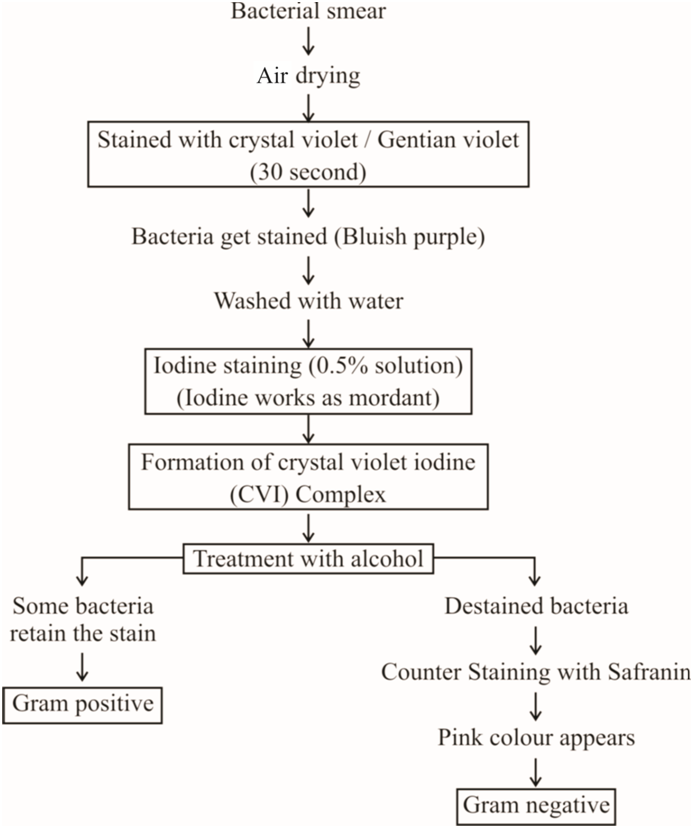
3. Surface Appendages : These include flagella and fimbriae (or pili).
(a) Flagella are long, fine, wavy, filamentous appendages that protrude through the cell wall, responsible for the motility of bacteria. These are much thinner than the flagella or cilia of eukaryotes.
Structure of Flagella: The entire flagellar apparatus is made up of three distinct regions: basal body, hook and filament.
Basal body: It is most complex portion of flagellum and has four rings (L, P, S and M), only two rings S and M are present in gram +ve bacteria. L and P rings in cell wall constitute distal set, while S and M rings are present in plasma membrane, forming proximal set.
Hook: Made up of different protein units.
Filament: Bacterial flagella are made up of identical spherical subunits of a protein called flagellin. Longitudinal chains of flagellin molecules run longitudinally around each other to form a wavy helical or rope-like structure. Therefore, a cross section of the flagellum reveals a number of flagellin molecules around a central space.
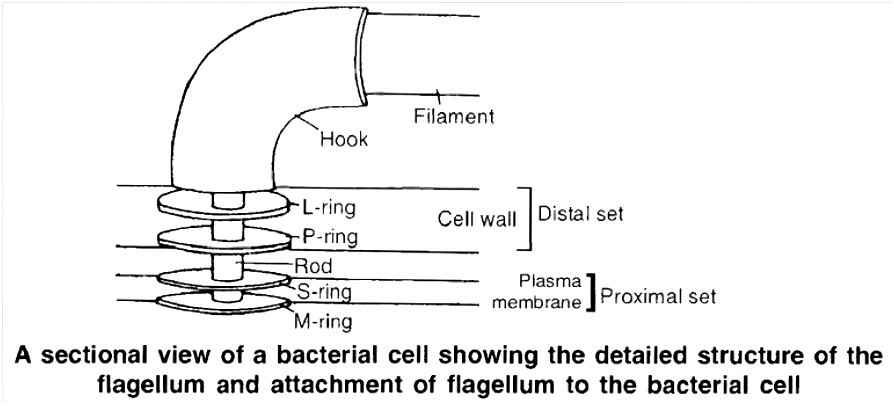
Concept Builder
Depending upon the presence or absence, number and position, following types of flagellar arrangements are observed among bacteria :
Atrichous: Flagella absent, e.g., Pasteurella, Lactobacillus.
Monotrichous: Only one flagellum attached at one pole of the organism, e.g.,Thiobacillus, Vibrio.
Amphitrichous: One flagellum at both ends, e.g., Nitrosomonas.
Cephalotrichous: Two or more flagella attached at one end, e.g., Pseudomonas fluorescence.
Lophotrichous: Two or more flagella attached at both ends, e.g., Spirillum volutans.
Peritrichous: Flagella distributed all over the surface of the cell, e.g., Escherichia coli, Clostridium tetani.
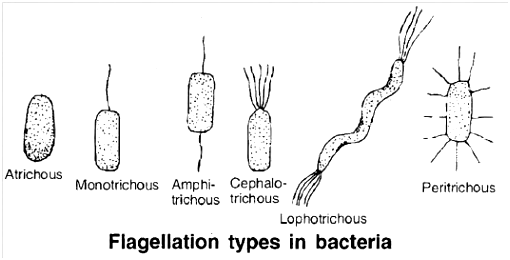
(b) Pili and fimbriae are hollow, non helical, filamentous appendages projecting from the walls of Gram-negative bacteria. These are thinner and shorter and more in number than the flagella. These are made up of specific proteins called pilin.
There are different types of pili which serve different functions. One type, known as type I pili, (somatic pili) play a major role in infection by facilitating the attachment of bacterial cell to the host cell. Another type, termed sex pili, serve as portals of genetic material from donor to recipient cell during conjugation.
Differences between Gram positive and Gram negative bacteria
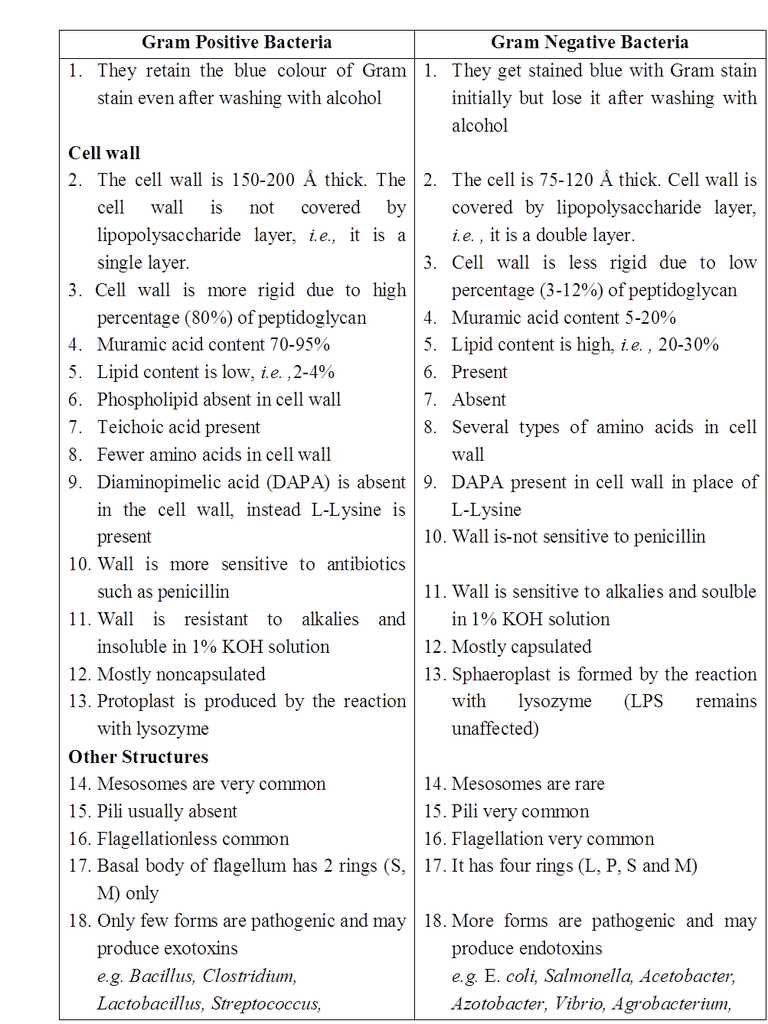
4. Protoplast: Cell wall encloses the protoplast, the living matter. It includes (i) Cell membrane (ii) Cytoplasm, (iii) Nucleoid and may have plasmid and episome.
(i) Cell membrane:
It lies inner to the cell wall, actually representing the outermost layer of the protoplast.
It is living and semipermeable, controlling the movements of various dissolved substances in and out of the cells.
Functionally, the cell membrane of bacteria resembles mitochondria of eukaryotic cells as respiratory ETS enzymes and succinate dehydrogenase (Kreb's Cycle) are associated with the membrane.
The cell membrane gets invaginated and folded to form a structure called mesosome (chondroid) in some bacteria, particularly the Gram positive bacteria.
These may be central or peripheral in position and they are supposed to play a role in replication of DNA during cell division, as these are often attached to the nuclear body.
Besides, these increase the surface area of absorption and help in septa formation during binary fission.
(ii) Cytoplasm:
It is homogenous colloidal mass of carbohydrates, fats, proteins, lipids, nucleic acids, minerals and water.
It does not show streaming movements.
It lacks sap vacuoles and gas vacuoles (may be present in some bacteria which live in aquatic condition).
Typical membrane bound organelles of eukaryotic cells like endoplasmic reticulum, mitochondria, golgi complex and plastids are absent.
The cytoplasm appears granular due to the presence of ribosomes.
However, these are 70S type in bacteria as compared to 80S type in eukaryotes.
Ribosomes lie scattered freely in the cytoplasm, but sometimes may form a small chain of 4-6 ribosomes attached to mRNA constituting polyribosome or polysome.
Various non living inclusions like glycogen particles, fat bodies, volutin granules (polymetaphosphate -source of energy) and lipid molecules acting as food reserve lie dispersed in the cytoplasm.
The cytoplasm is usually colourless, lacking pigments.
However, in photosynthetic bacteria, the cytoplasm contains pigments like bacteriochlorophyll and bacterioviridin.
The pigments either lie dispersed in the cytoplasm or present in membrane bound spherical vesicles called chromatophores.
These pigments are capable of entrapping solar energy for photosynthesis
(iii) Nucleoid (Prochromosome, Genophore, Incipient nucleus) –
Bacterial cell lacks a well organized nucleus.
It consists of a long double stranded DNA molecule repeatedly folded with the help of RNA to form a circular ring.
DNA has no free ends and not associated with histone proteins (polyamines present). Circular DNA ring, without histones is often termed bacterial chromosome.
Plasmid (Minichromosome) :
Term plasmid was given by Lederberg and Hays.
These are small, extrachromosomal, non-essential, circular, double stranded, free naked DNA molecules.
The genes present on them have no vital role in survival and growth of bacteria.
These perform autonomous replication.
If plasmids temporarily integrate with bacterial chromosome, then they are called episomes.
Concept Builder
Types of plasmids :
(a) F-Plasmid: It forms sex pilus and is responsible for process of conjugation or fertility factor transfer.
(b) R-Plasmid: These plasmids have resistance gene (Resistance Transfer Factor, RTF) for antibiotics like penicillin, tetracycline.
(c) Col-Plasmid: Genes of this plasmid are responsible for production of colicins (bacteriocin) for killing other bacteria.
(d) Ti Plasmid: From Agrobacterium tumefaciens, used in genetic engineering
(e) Degradative plasmid of Pseudomonas putida (superbug) helps to decompose hydrocarbons of petroleum in oil spills
5. Bacterial Life Processes
Discussion of bacterial life processes revolves around the study of the prominent metabolic activities like respiration and nutrition.
(A) Respiration: On the basis of mode of respiration, the bacteria are divided into two main groups: i.e., aerobes and anaerobes. Each group is further of two types i.e. strict or obligate and facultative.
(a) Obligate or strict aerobes : These bacteria can live only in presence of oxygen they possess the enzyme system for aerobic respiration only. In the absence of oxygen, they cannot respire and thus, die, e.g., Bacillus subtilis.
(b) Facultative anaerobes : They normally respire aerobically. However, they are capable of switching over to anaerobic mode to get energy for their survival, if sufficient oxygen to sustain aerobic respiration is not available in the environment, e.g., Pseudomonas.
(c) Obligate or strict anaerobes: These bacteria respire anaerobically only. The growth of such bacteria will certainly be slower as anaerobic respiration liberates much less amount of energy as compared to aerobic respiration. They lack enzymes necessary for carrying out aerobic respiration e.g., Clostridium botulinum.
(d) Facultative aerobes: They normally respire anaerobically, but are capable of respiring aerobically as well, if oxygen is available. Most of the photosynthetic bacteria are facultative aerobes e.g., photosynthetic bacteria Chlorobium.
Concept Builder
(i) Aerotolerant anaerobes: Bacteria that continue to perform anaerobic respiration even in the presence of oxygen, e.g., Lactic acid bacteria.
(ii) Anaerotolerant aerobes: Aerobic bacteria continue to perform aerobic respiration even in absence of free oxygen by using oxygen of oxidised salts, e.g., Denitrifying bacteria
(B) Nutrition :
Nutrition in bacteria is of two types i.e. autotrophic and heterotrophic.
Bacteria having autotrophic mode of nutrition may be photoautotrophs and chemoautotrophs, carrying out photosynthesis and chemosynthesis, respectively.
(I) Autotrophic Nutrition
(i) Photoautotrophic bacteria:
These bacteria are capable of entrapping solar energy and utilizing it for the synthesis of complex food materials due to the presence of pigments like bacteriochlorophyll (bacteriopurpurin) and bacterioviridin.
Purple sulpher bacteria (e.g., Thiospirillum) and green sulpher bacteria (Chlorobium limicola) are the most familiar examples containing pigment bacteriochlorophyll, bacteriopurpurin and bacterioviridin respectively.
Concept Builder
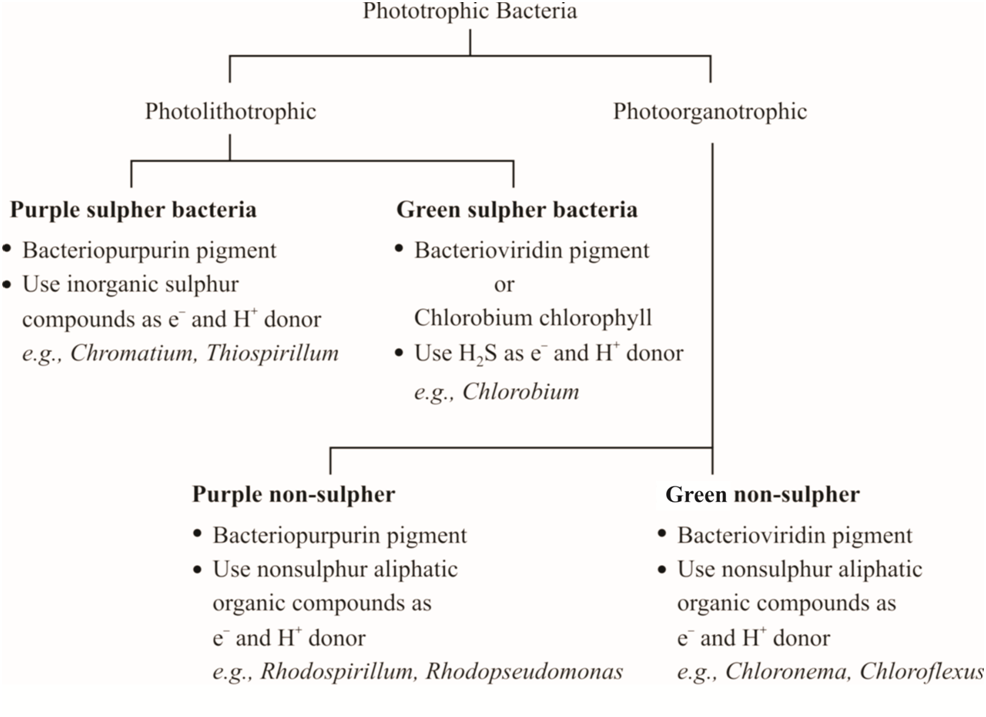
Bacterial photosynthesis, however, differs from photosynthesis of higher plants in not liberating oxygen.
This type of photosynthesis, characteristic of bacteria, is termed as anoxygenic.
Normal photosynthesis, occurring in higher plants, is termed as oxygenic.
In bacterial photosynthesis water is not the source of electron that acts as reducing power to convert CO2 into glucose.
The bacteria obtain reducing power from various compounds such as hydrogen sulphide, thiosulphate or even some organic compounds.
No oxygen is evolved as it does not involve splitting of water.
Hydrogen released by various compounds mentioned above is picked up by NAD+ which gets reduced to NADH2 acting as reducing power.
NADH2 alongwith ATP, produced generally by entrapping solar energy are used to reduce CO2 to glucose.
Simple equation for anoxygenic photosynthesis may be written as follows :

Most of the photosynthetic bacteria are anaerobes (facultative aerobe
(ii) Chemoautotrophic Bacteria:
Bacteria belonging to this category obtain energy for the synthesis of food by oxidising certain inorganic substances like ammonia, nitrates, nitrites, ferrous ions etc.
Thus, they do not utilise light as energy source.
The chemical energy thus obtained, is trapped in ATP molecules.
This energy is then used in carbon assimilation with the help of hydrogen from some source other than water, e.g., hydrogen bacteria, nitrifying bacteria, sulphur bacteria, etc.
They play a great role in recycling nutrients like nitrogen, phosphorous, iron, sulphur.
(a) Hydrogen bacteria. These bacteria oxidise hydrogen in the presence of oxygen, e.g., Hydrogenomonas.
(b) Nitrifying bacteria obtain energy by oxidizing ammonia into nitrate, oxidation of ammonia occurs in two steps. Each step is carried out by a specialised group of bacteria.
In the first step, ammonia is oxidised into nitrites by the species of the genus Nitrosomonas and Nitrococcus.
In the second step, the nitrite is converted into nitrate. This is brought about by species of the genus Nitrobacter and Nitrocystis which use this energy for chemosynthesis.
(c) Sulpher bacteria. These bacteria obtain energy either by the oxidation of elemental sulphur or oxidation of H2S.
Oxidation of elemental sulpher. Sulpher bacteria (Thiobacillus thioxidans) oxidise elemental sulpher to sulphuric acid and utilise energy produced in this process. These bacteria can survive even in extreme acidic environment.
Oxidation of H2S to S. Some bacteria like Beggiatoa use the energy from oxidation of H2S and store the sulphur so produced in the form of granules.
(d) Iron bacteria. These bacteria (e.g., Ferrobacillus, Leptothrix) inhabit water which contain iron compounds. These bacteria convert ferrous ions to ferric form. The ferric ion is deposited as insoluble ferric hydroxide. The energy so released, is utilised in the assimilation of CO2.
(e) Methane bacteria. Methanomonas, is one example which oxidises methane to carbon dioxide.
(II) Heterotrophic bacteria :
These bacteria are most abundant in nature and are incapable of synthesizing their own food from simple raw materials.
They obtain nourishment either from dead and decaying organic matter or directly from a living host.
All heterotrophic bacteria are segregated into three main categories, i.e., saprophytic, symbiotic and parasitic forms.
(i) Saprophytic bacteria :
They are free living bacteria, obtaining nourishment from organic remains such as dead animals, animal excreta, fallen leaves, decaying vegetables, fruits, bread and other products of animal and plant origin.
These bacteria secrete digestive enzymes into the substrate and the complex insoluble Substances are converted into simple soluble compounds like water, hydrogen sulphide, ammonia, CO2 etc.
Some of the simpler substances are absorbed and assimilated by the bacteria, whereas the others are added to the soil and atmosphere to complete the nature's material cycle.
Anaerobic breakdown of carbohydrates and proteins is termed fermentation and putrefaction respectively.
Aerobic breakdown of organic compounds is called decay.
(ii) Symbiotic bacteria :
They are mainly Gram negative type.
A familiar example of symbiotic bacteria is Rhizobium leguminosarum, associated with roots of leguminous plants.
They are capable of fixing atmospheric nitrogen as ammonia, inside the nodule only and not in free state.
However, some bacteria like Azotobacter, Beijerinckia, Klebsiella are free living, aerobic and capable of nitrogen fixation in free state, enriching the soil.
Clostridium pasteurianum is anaerobic N2 fixing bacteria.
(iii) Parasitic bacteria
These bacteria draw nourishment and obtain special organic compounds required for growth from living organisms, either plants or animals, called hosts.
The disease causing bacteria are termed pathogenic and the ones not causing any disease are termed as non-pathogenic.
6.. Reproduction
Bacteria reproduce mainly by asexual method and also show sexual recombination (True sexual reproduction is absent).
A. Asexual Reproduction :
Bacteria produce several types of asexual spores like, sporangiospores, oidia, conidia and endospores. However, the most common mode of asexual reproduction is binary fission.
Under favourable conditions of nutrient availability, moisture and temperature, daughter cells may repeat binary fission many times and may forms a large population.
Fortunately, such a rapid rate is seldom achieved.
The process gradually slows down and ultimately stops because of:
(i) Shortage of space.
(ii) Lack of nutrient availability.
(iii) Accumulation of waste products (making environmental conditions unfavourable for growth).
(iv) Development of bacteriophages, destroying bacteria.
(a) Binary Fission :
It is the most common method under favourable conditions of temperature, moisture and availability of nutrients.
Mature bacterial cell divides into two daughter cells.
In this process the cell division is amitotic type i.e., not involving the spindle formation
(b) Endospores :
Cells of certain bacteria, e.g., Bacillus, Clostridium etc. form thick-walled, highly resistant bodies within the cell, called endospores.
One bacterial cell normally produces only a single endospore.
The endospores may be spherical or oval in shape and are terminal or central in position.
Anticoagulant nature of endospore is due to the presence of Ca-dipicolinic acid in cortex layer of wall.
Concept Builder
Structure of Endospore :
The endospore consists of a central core made up of nuclear material and spore cytoplasm.
The cytoplasm includes DNA, RNA and proteins, lipid, Ca, Mn.
The central core is surrounded by a delicate membrane called core wall.
Around the wall is another layer, which is much thicker and is of relatively low density.
This layer, called cortex, mainly consists of peptidoglycan and calcium dipicolinic acid (CaDPA).
It is an anticoagulant which provides resistance to heat.
This complex may also be present in spore cytoplasm.
Endospore is highly resistant to desiccation, chemicals and radiations.
The cortex, in tum, is enclosed in spore coat which may be smooth, grooved, or raised into ridges. The whole structure may be wrapped in an exosporium.
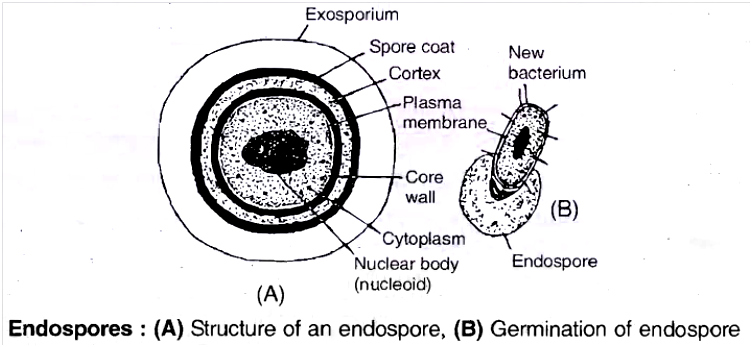
The endospores are formed probably upon induction by the exhaustion of nutrients (unfavourable conditions).
During endospore formation, a part of the protoplast containing nuclear body undergoes dehydration, stores food material and gets separated from rest of the protoplast to form endospore.
It gets surrounded by different layers.
These can withstand temperature as high as 1000e or as low as -100°C, so these can remain unharmed during pasteurisation.
The remarkable resistance shown by endospores is due to :
(i) Thick and impermeable spore coat
(ii) Low water content
(iii) Low metabolic activity
(iv) Ca-DPA Complex
Under favourable conditions, endospore absorbs water, becomes metabolically active, ruptures thick spore coat and the bacterium surrounded by thin cell wall emerges out.
Endospores are actually the means of perennation and not reproduction as only one endospore is formed per cell and subsequently each endospore grows into single bacterium cell after the commencement of favourable conditions.
B. Sexual Recombination (Genetic Recombination) :
The bacteria exhibit a primitive form of sexual reproduction which differs from eukaryotic sexual reproduction because there is no gamete formation and fusion.
However, the essential feature of sexual reproduction, i.e., exchange of genetic material does take place and is called genetic recombination.
Three methods are known by which genetic recombination is achieved by bacteria.
In the order of their discovery, these are transformation, conjugation and transduction.
(a) Transformation :
Griffith (1928) worked on the effect of Diplococcus or Streptococcus pneumoniae bacteria on mice and discovered the process of transformation.
In transformation, the donor and recipient do not come in contact.
The donor cell releases a piece of DNA which is actively taken up by the recipient cell from the solution.
This ability to pick up DNA from the solution is called competence.
Two strains of D. pneumoniae are :
- Capsulated or S-III (Virulent strain) and Non-capsulated or R-II (non-virulent strain).
- Four steps were performed in experiment:
![]()
![]()
![]()
![]()
(But R-II is not virulent and S-III lost its virulent capacity upon heating).
Griffith concluded that 'something' passed from heat killed S-III to R-II bacteria, so that non virulent strain changed or transformed into virulent bacterial strain.
Avery, Macleod and McCarty (1948) repeated this experiment using various enzymes and proved that the transformation principle is DNA of heat killed S-III strain.
They proved that DNA is a genetic material.
(b) Conjugation:
Lederberg and Tatum (1946) demonstrated in E. coli that during conjugation, one cell containing F-plasmid acts as donor (F+ or male) cell and the other lacking F-plasmid as recipient (F– or female) cell.
The plasmid contains fertility factor or F gene which produces protrusions termed sex pili.
These help the donor F+ cell in attaching to the recipient cell.
The plasmid replicates and a replica is transferred to recipient cell, changing it into F+.
Often the plasmid integrates with bacterial chromosome, converting it into Hfr (High frequency of recombination) cell or super male and a part or whole of bacterial chromosome is transferred to recipient cell through-conjugation tube.
Such association of episome with the endogenote increases the efficiency of genetic transfer.
The number of genes transferred depends upon the time for which the two cells remain joined together.
When F-conjugates with super male, the frequency of recombination increases by 1000 times, that is why it is called as Hfr (super male).
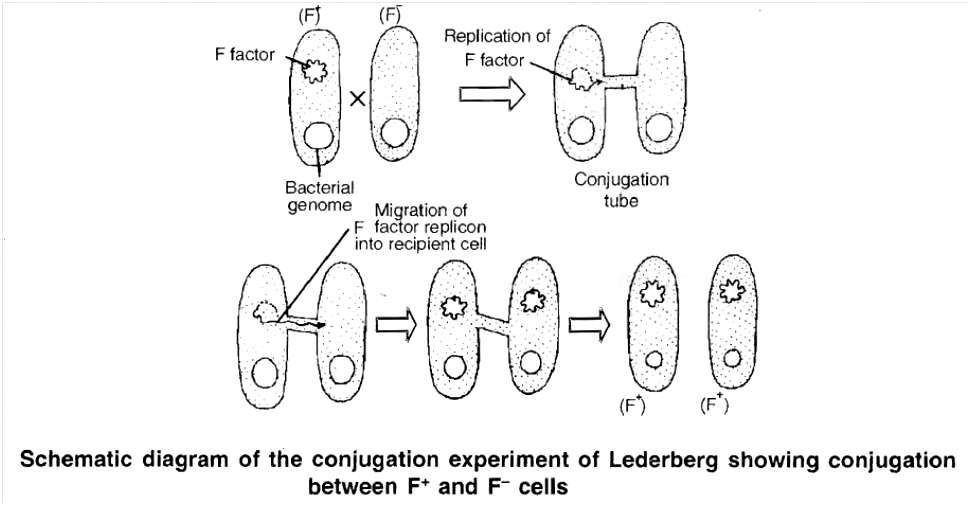
(c) Transduction :
During transduction, a small double stranded piece of DNA is transferred from donor to recipient by a bacteriophage.
This mode of genetic recombination in bacteria was first demonstrated by Zinder and Lederberg (1952) while working with Salmonella typhimurlum.
Some viruses have the ability to integrate their DNA with bacterial DNA, which is replicated at the same time as the host DNA and is passed from one bacterial generation to the next.
Such bacteria carrying phage (viral) DNA with their own DNA are called lysogenic bacteria.
Occasionally, the phage DNA becomes active and codes for the production of new virus particles.
A number of phage particles are synthesised followed by the destruction of the host cell and release of phage particles.
Upon release, the phage particles attack sensitive bacterial cells, multiply and release more phage particles.
However, sometimes faulty deatchment of phage DNA from bacterial DNA results in the incorporation of a small amount of bacterial DNA into the phage DNA.
Subsequent infection of another bacterium with this aberrant phage called transducing phage, introduces the piece of foreign bacterial DNA into the recipient's chromosomes, producing a genetic change.
Types of transduction:
The ability of the bacteriophage to carry the genetic material from any region of bacterial DNA is called generalised transduction, e.g., T4-phage.
On the other hand, there are bacteriophages such as lambda phage (l) of E coli which can carry only a specific region of the bacterial DNA to a recipient.
This is called specialised transduction (or restricted transduction).
Sometimes, the DNA brought by the phage does not integrate with the genome of the recipient bacterium and is lost after one or two generations.
Such a transduction is called abortive transduction
7. Economic Importance of Bacteria
Bacteria play significant role in day to day activities of human beings.
A. Beneficial activities
(a) Role in agriculture
(i) Decay and decomposition of organic matter :
They bring about decay and decomposition of dead remains of plants and animals.
These are the most important for mineral cycling to occur.
(ii) Sewage disposal :
The bacteria decompose the organic matter present in the sewage, converting into simpler inorganic substances.
The inorganic substances thus formed, being soluble, pass out through filter alongwith water which is highly useful for irrigation purposes, e.g., Clostridium, E. coli.
(iii) Nitrogen cycle :
The proteins present in dead remains of living organisms are converted into amino acids by different types of saprophytic bacteria.
Amino acids are converted into ammonia by ammonifying bacteria (Bacillus vulgaris, B. ramosus).
Nitrifying bacteria convert ammonium salts first into nitrites (Nitrosomonas, Nitrococcus) which are subsequently converted into nitrates (Nitrobacter).
In presence of denitrifying bacteria (Pseudomonas denitrificans), nitrates and nitrites of soil are converted to gaseous nitrogen.
(iv) Nitrogen fixation :
It is the biological process in which atmospheric nitrogen is converted into nitrogenous compounds by nitrogen fixing bacteria.
These bacteria are of 2 types :
(a) Free living
(b) Symbiotic
(a) Free living bacteria are Azotobacter and Beijerinckia (aerobic) & Clostridium (anaerobic).
(b) Common symbiotic bacteria are Rhizobium leguminosarum and Xanthomonas. These convert nitrogen into ammonia which is directly converted into amino acids by plants.
(v) Manure preparation :
Saprotrophic bacteria help in preparation of farmyard manure by converting farm refuse, dung and other organic wastes into humus.
(b) Role in Industry :
Man has utilized the metabolic activities of bacteria in preparation of a number of industrial products as listed below :
(i) Butter milk and sour cream
(ii) Yoghurt
(iii) Cheese
(iv) Vinegar
(v) Retting of fibres : Retting is a controlled microbial decomposition for separation of fibres. The tissues are immersed in water tanks where anaerobic butyric acid bacteria dissolve the pectin of middle lamella of cells, thus, separating the fibres. Clostridium perfringens and Pseudomonas fluorescence are useful in this process.
(vi) Curing of leaves: To improve the flavour and taste in tea, using Micrococcus candidans and in tobacco leaves by Bacillus megatherium.
(vii) Single cell proteins (SCP) : Like -Methylophilus methylotropus and Rhodopseudomonas capsulata.
(c) Role in Medicine :
Bacteria have been used extensively in preparation of antibiotics, vaccines, serums and vitamins.
(i) Antibiotics :
The term antibiotic was given by Waksman, who discovered streptomycin.
These are the organic substances produced by microorganisms which inhibit the growth of other organisms (mostly pathogens) but do not affect the growth of organisms secreting these.
The first commercial antibiotic penicillin was discovered by Flemming (1959) from a fungus called Penicillium.
Some antibiotics of eubacterial origin:
(a) Bacitracin ........................... Bacillus licheniformis
(b) Polymixin ........................... Bacillus polymyxa
(c) Gramicidin ........................... B. brevis
(d) Subtilin ........................... B. subtilis
(ii) Vaccine production
Vaccines and serums against typhoid, cholera, TB, pertussis, tetanus and diphtheria are made with the help of bacteria or their toxins e.g., DPT (against diphtheria, pertussis and tetanus), TI(against tetanus), BCG (Bacille of Calmette-Guerin against TB), DT (against diphtheria and tetanus).
(iii) Vitamins :
Escherichia coli present in human intestine produces large quantities of B-complex vitamins and vitamin K. Bacteria are utilized in industrial production of a number of vitamins like riboflavin from Clostridium butylicum, Cobalamine (B12) from Bacillus megatherium and Pseudomonas denitrificans.
(iv) Pollution control :
Pseudomonas putida degrades petroleum wastes.
Flavobacterium can decompose 2, 4-D. DDT can be decomposed by Acetobacter aerogens.
Ganga's water contains Bdellovibrio bacteriovorus that maintains purity of its water.
(v) Poly--hydroxybutyrate is used to produce biodegradable plastic.
B. Harmful activities
(i) Spoilage of food : Saprophytic bacteria cause decay of vegetables, fruit, meat, bread and other foods, making these unfit for human consumption. Some bacteria even produce strong toxins in the infected food stuffs which cause food poisoning when consumed.
(ii) Deterioration of Domestic Articles : Some saprophytic bacteria like Cellulomonas, Spirochaete cytophaga cause deterioration of domestic articles of daily use such as leather, woolen, canvas articles etc.
(iii) Denitrification of Soils : Denitrifying bacteria like Thiobacillus denitrificans, Micrococcus denitrificans and Pseudomonas convert nitrates and nitrites present in the soil into gaseous nitrogen, thus depleting the soil nitrogen, thereby decreasing soil fertility.
(iv) Desulphurification : Desulphovibrio desulphuricans.
(v) Diseases : Common disease of humans, animals and plants are listed below respectively –
Table: 2
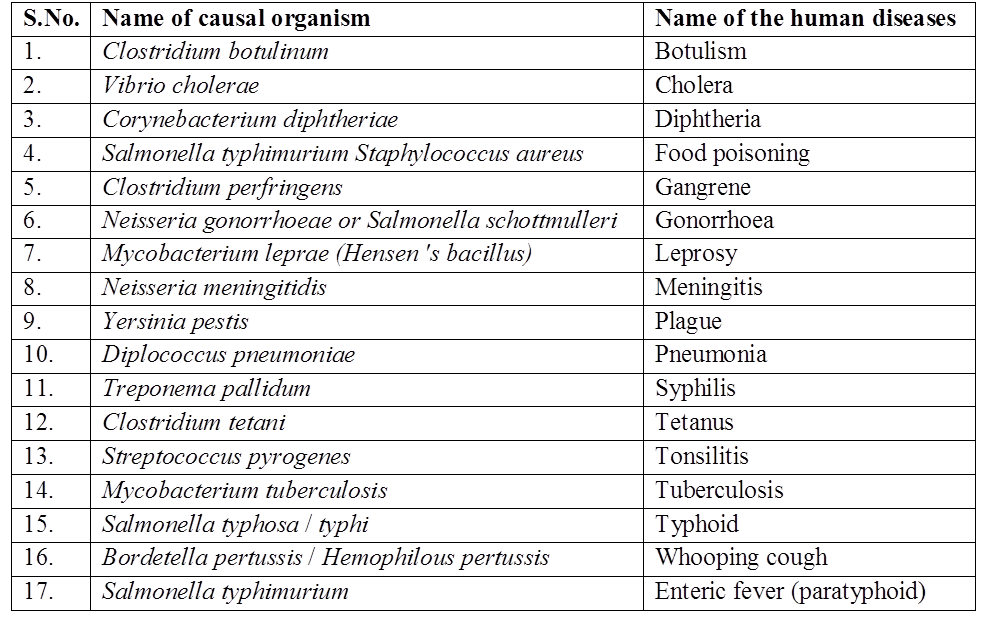
Table : 3
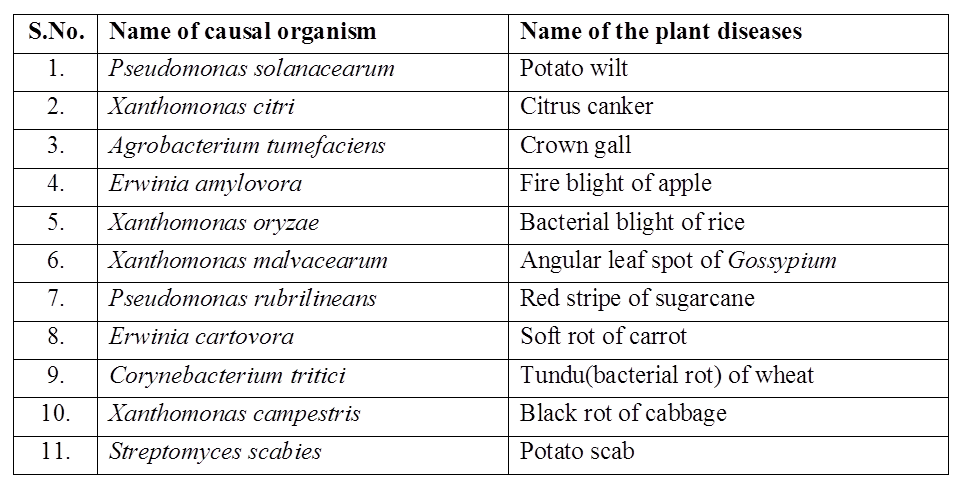
II. CYANOBACTERIA
Cyanobacteria are Gram negative photosynthetic prokaryotes, being the most primitive organisms to have oxygenic photosynthesis.
They added oxygen to the atmosphere, which is indispensible for the existence of aerobic forms of living organisms.
They are also known as BGA (Blue green algae) and are classified variously under cyanophyceae or myxophyceae.
Occurrence
They are mainly fresh water forms, though few are marine.
Red sea is named so because of abundant occurrence of a cyanobacterium Trichodesmium erythraeum, which imparts red colouration to water.
They occur in symbiotic association with almost every group of eukaryotes i.e. green algae, fungi, bryophytes like mosses and Anthoceros, ferns, gymnosperms, angiosperms, sponge, shrimps, mammals etc.
Anabaena azollae is associated with Azolla, an aquatic fern.
Anabaena cycadeae is associated with coralloid roots of Cycas.
In many lichens (symbiotic association of algae and fungi), the algal partner may be a cyanobacterium.
When they live endozoically in protozoans they are called cyanelle.
Structural Organization
These may be unicelled or multicelled. The latter may be filamentous or colonial.
Filamentous form consists of one or more cellular strands, called trichomes, surrounded by mucilagenous sheath.
Cyanobacteria are characterised by the absence of flagellum throughout life cycle.
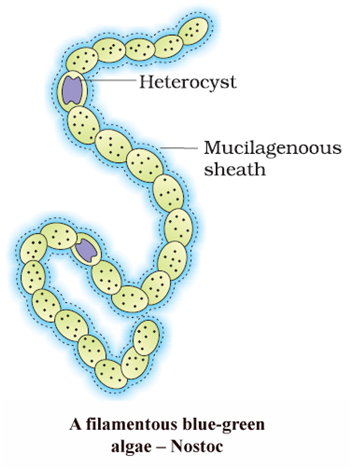
Cell Structure
- The cell structure in cyanobacteria is typically prokaryotic.
- The cell lacks a well defined nucleus and the chromatin material is centrally located, resembling the bacterial chromosome.
- The cell wall is 4 layered and is invariably covered by mucilagenous sheath, composed largely of mucopeptides.
- Protoplasm in cyanobacterial cell can be distinctly divided into two parts the centroplasm and chromoplasm.
- The central colourless centroplasm contains the chromatin material.
- The peripheral protoplasm is coloured or pigmented because of the presence of thylakoids, called as chromoplasm.
- The protoplast lacks membrane-bound organelles like endoplasmic reticulum, golgi bodies, mitochondria, lysosomes, plastids and contains 70S ribosomes.
- Similar to the mesosome of bacteria, a group of coiled membrane called lamellasome is found which connects nucleoid to the cell membrane.
- It helps in respiration and replication of DNA.
- The cell membrane lack sterols. The sap vacuoles are absent.
- Instead, the cell may contain gas filled vacuoles which help to regulate the buoyancy of the organism in water.
- The characteristic feature of cyanobacterium cell is the presence of a system of photosynthetic lamellae called thylakoids.
- The characteristic photosynthetic pigments present in the thylakoids are chlorophyll a and phycobilins i.e., phycocyanin (blue coloured), phycoerythrin (red coloured) and allophycocyanin (light blue coloured).
The cyanobacterial cell contains reserve food material in the following forms
(i) Cyanophycean granules (Protein)
(ii) ![]()
(iii) Cyano-or myxophycean starch or -granule (Similar to glycogen but negative to iodine test)
(iv) Volutin body (Reserve phosphate)
(v) Polyhedral body (Rubisco rich)
Concept Builder
Gaidukov's phenomenon or complementary chromatic adaptation -Cyanobacteria or blue green algae can adaptively change their body colour according to different wavelengths of available light, e.g., Trichodesmium erythraeum. It is also known as "red sea" causing alga.
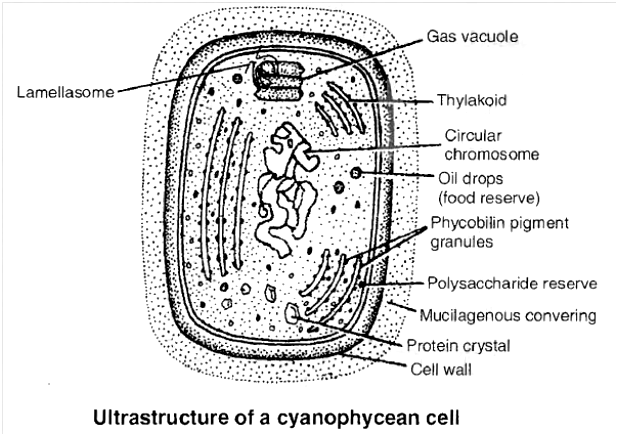
Metabolism
They are the most self-dependent organisms, because most of these are capable of converting atmospheric nitrogen into ammonium compounds besides utilizing atmospheric CO2 for synthesis of organic food during photosynthesis.
Biological nitrogen fixation is an anaerobic process as nitrogenase enzyme required for the process acts efficiently in the absence of oxygen.
Nitrogen fixation under anaerobic conditions occurs mainly in large, specialized cells called heterocysts as in Nostoc.
Heterocyst has terminal pores which at maturity develops a polar granule.
Thickened cell wall of these cells is impermeable to oxygen so this creates anaerobic environment in the cell even under aerobic conditions.
Besides this, heterocysts also lack PS II activities and CO2 fixation is done only by vegetative cells.
Oxygen is not evolved due to absence of PSII.
However, PSI remains active in heterocyst which generates ATP required to fix nitrogen.
Besides N2 fixation heterocyst promotes fragmentation.
This property of nitrogen fixation, most of the BGA enrich the soil by releasing nitrogenous compounds in the surroundings.
Reproduction
Cyanobacteria reproduce asexually. Typical sexual reproduction is absent.
Asexual reproduction occurs by following methods :
(i) Binary fission: It occurs in unicellular forms. The daughter cells formed by amitotic division separate immediately after the division.
(ii) Fragmentation: It occurs in filamentous forms. The filament breaks up into short pieces or fragments which grow to form new filaments.
(iii) Heterocysts : Under special conditions, the heterocysts germinate to form new filaments.
(iv) Hormogonia: Due to the formation of biconcave, mucilage filled dead cells called necridia, in between living cells of trichome, the filament breaks into hormogonia.
(v) Akinetes: Vegetative cells are transformed into thick walled akinetes due to the deposition of food material followed by the thickening of wall. On the arrival of favourable conditions, they germinate to form new filaments.
Importance of Cyanobacteria
(i) They are the most ancient organisms having oxygenic photosynthesis and thus, played a significant role in the evolution of aerobic forms of life.
(ii) They convert atmospheric nitrogen into ammonium compounds and excess of these compounds is excreted out, enriching the soil. The death and decay of these also increase the soil fertility, particularly the nitrogen content of the soil. Tolypothrix and Aulosira fix N2 non-symbiotically in rice fields .
Cyanobacteria like Nostoc and Anabaena have been used for reclaiming usar soils. As they can live in damp or aquatic habitat, they enrich the root environment in any wetland condition as in rice fields.
(iii) Cyanobacteria are associated in symbiotic relationship with almost every group of plants. They benefit the partner by providing nitrogenous compounds because of their capability of nitrogen fixation.
(iv) Some cyanobacteria serve as food to several aquatic animals. Spirulina is edible, non-toxic, fast growing cyanobacterium. It is cultivated in tanks as source of protein rich animal food (SCP).
(v) Extract of Lyngbya is used for the manufacture of antibiotic.
(vi) Some cyanobacteria like Microcystis aeruginosa, Anabaena flos-aquae, Aphanizomenon flos-aquae are known to cause algal blooms in water bodies. These also secrete toxins into the surroundings, which are harmful to aquatic animals and even to human beings. Water from such sources is harmful and may even prove fatal for organisms drinking it. They also deplete the oxygen from the water reservoir and thereby, cause large scale death of the fishes and other aquatic animals.
III. MYCOPLASMA
E. Nocard and E.R. Roux (1898)-two French Scientists, discovered these organisms from pleural fluid of cattles suffering from pleuropneumonia.
These are pleomorphic and were called PPLO (Pleuropneumonia Like Organisms) or Jokers of plant kingdom.
This organism was later on given the name Asterococcus mycoides by Borrel et al. (1910).
Nowak (1929) placed Asterococcus mycoides under the genus Mycoplasma.
All such organisms are now called Mycoplasma, or MLO's (Mollicutes like organisms).
These are sometimes placed in a separate class called Mollicuta.
Mycoplasma infects animals (e.g., dog, sheep, mice and man) and plants (e.g., potato, corn, brinjal etc.).
- They are generally found in soil, sewage water, plants and animals.
Structure:
These are unicellular, simplest free living prokaryotes.
They do not have cell wall so they are highly pleomorphic and can assume various shapes like spherical, granular, filamentous, coccoid etc.
Cell membrane is the outermost limiting layer.
It is trilamellar unit membrane structure.
In culture, colonies of mycoplasma show a characteristic fried egg appearance with an opaque central area and translucent peripheral zone.
The cells are generally non motile, but a few are gliding type.
The protoplasmic matrix contains ribosomes (70S type), fatty acid substances and proteins.
Organized nucleus, endoplasmic reticulum, plastids, mitochondria, golgi bodies, Iysosomes, centrioles, flagella, etc. are absent.
Mycoplasma has both RNA and DNA.
RNA is single stranded, present in both ribosomes and cytoplasm and DNA is double stranded, long coiled thread extending almost throughout the cell.
Enzymes are present freely in the cytoplasm as well as associated with the plasma membrane.
Replicating disc assist in replication and separation of the genetic material.
Nature of Mycoplasma:
Mycoplasma can pass through bacteriological filters and lack cell wall.
This shows that they are not bacteria.
Since they can multiply in abiotic medium having sterols, so they are not considered as virus.
Due to many similarities with bacteria they are said to be "Bacteria with their coats off".
Mode of nutrition is heterotrophic.
Some are saprophytic, but mostly they are parasitic.
They are parasitic, because they are unable to synthesize required growth factors, e.g., M. gallisepticum (0.3 to 0.5 µm, smallest prokaryote).
They can survive without oxygen.
Sensitivity to Antibiotics:
Mycoplasma are Gram negative, insensitive to penicillin but sensitive to streptomycin, erythromycin, chloramphenicol (metabolic inhibitors) etc.,
They are insensitive to penicillin because they are wall less and penicillin interferes in the synthesis of peptidoglycan, a component of cell wall of bacteria.
Reproduction - Much is not known about reproduction of Mycoplasma but they mainly reproduce by means of elementary bodies.
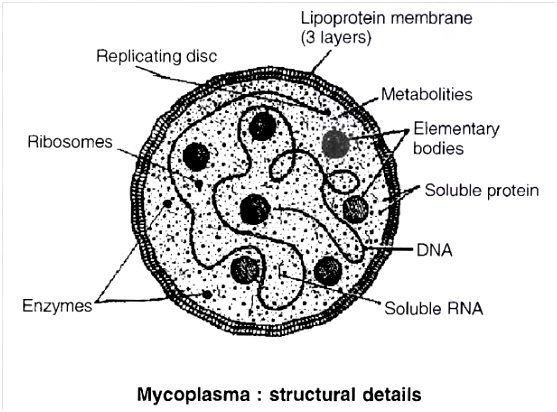
Concept Builder
Mycoplasmas cause various diseases in plants, animals and human beings.
Some are given below :
1. Plant diseases: The Mycoplasma diseases are generally transmitted through insects such as leaf hopper, mites and flies.
(i) Witches' broom (ii) Aster yellow
(iii) Brinjal little leaf (iv) Bunchy top of Papaya
(v) Sesame phyllody (vi) Sandal spike
2. Diseases in animals
(i) Pleuropneumonia in cattle
(ii) Inflammation of genitals
3. Diseases in human beings
(i) Infertility in man
(ii) Primary atypical pneumonia
IV. ARCHAEBACTERIA
They are believed to have evolved immediately after the origin of life on earth, as even now these are living under extremely adverse conditions such as extreme salty areas (halophiles), hot springs (thermoacidophiles) and marshy areas (methanogens).
Very few other organisms can survive under such environmental conditions. So these are termed as "living fossils".
These possess introns in DNA, their ribosomal proteins are highly acidic, these prokaryotes possess histone proteins different from that of eukaryotes.
These being the most primitive and ancient most bacteria.
Archaebacteria differ from other bacteria in having a different cell wall structure and this feature is responsible for their survival in extreme conditions.
The cell wall in archaebacteria contains proteins and non-cellulosic polysaccharides.
It lacks peptidoglycan, the characteristic cell wall material in bacteria and cyanobacteria.
It consists of glycoprotein, pseudomurein and non cellulosic polysaccharide.
Pseudomurein is like bacterial peptidoglycan, but contain N-acetyltalosaminuronic acid instead of NAM and lacks D-Amino acid.
The cell membrane contains branched chain lipids (phytanyl side chains) which decreases membrane fluidity.
This chemical composition of the cell membrane enables these organisms to withstand extremes of temperature and pH.
Archaebacteria are divided into three groups· methanogens, halophiles and thermoacidophiles
(a) Methanogens:
They are obligate anaerobes occurring in marshy habitats.
They are capable of converting CO2, methanol and formic acid (HCOOH) into methane and hence the name methanogens.
This property is exploited commercially in the production of fuel gas and methane in gobar gas plants (biogas fermenters).
Some of the methanogens live in rumen of herbivorous animals like buffalo, cow etc. (ruminants).
These microorganisms assist in fermentation of cellulose in such animals, e.g., Methanococcus, Methanobacterium, Methanosarcina, Methanospirillum.
(b) Halophiles:
They are aerobic chemoheterotrophic coccoid forms and are Gram negative. They occur in high salt concentration medium like sea, salt lake, brines, marshes, salted field etc.
In high light intensity a reddish pigment bacteriorhodopsin develops in their membrane to trap sun light to produce ATP, but they cannot use this ATP in food synthesis.
Sap vacuoles are absent in halophiles, hence, they cannot get plasmolysed in high salt concentration.
They maintain a high osmotic concentration of KCl in their cells.
These bacteria get lysed if NaCl level falls below 10%, e.g., Halococcus, Halobacterium.
These can grow well in a medium containing 25-30% of NaCl.
(c) Thermoacidophiles:
They are capable of tolerating high temperature as well as high acidity and hence, the name thermoacidophiles.
They often live in hot-water springs where the temperature is as high as 80°C and the pH as low as 2.
They oxidise sulphur to sulphuric acid under aerobic conditions and the energy obtained in this reaction is utilized for the synthesis of organic food.
The medium becomes highly acidic due to the production of sulphuric acid. Under anaerobic conditions sulphur is reduced to H2S, e.g., Thermoplasma, Thermoproteus, Thermococcus. Hence, these are chemosynthetic in nature.
Concept Builder
Thermoacidophiles are capable of withstanding extremely low pH and high temperature due to:
(a) The cell membrane containing branched chain lipids
(b) The presence of resistant enzymes which can operate under acidic conditions.
It seems probable that archaebacteria, living in extreme environmental conditions got separated from the main line of bacterial evolution quite early. They survived through long period of geological changes successfully, existing at present and are perhaps the oldest "living fossil".
V. ACTINOMYCETES (Ray Fungi)
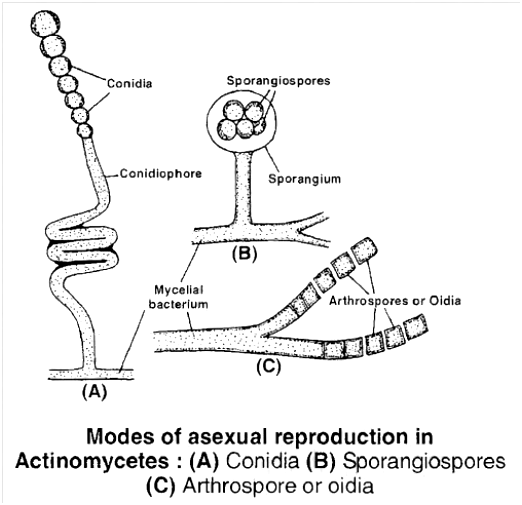
(1) These are branched, filamentous bacteria and are considered as intermediate form between bacteria and fungi, e.g., Nocardia, Mycobacterium, Corynebacterium, Frankia, Streptomyces.
(2) These filaments form radiating colonies in cultures so are also called mycelial bacteria.
(3) Cell wall contains peptidoglycan and is Gram positive in nature. It contains mycolic acid.
(4) They are facultative anaerobic, saprophytic, non-motile and are important decomposers of dead organic matter.
(5) They reproduce commonly by conidia, sporangiospore, oidia and fragmentation.
(6) They are acid fast in nature.
Concept Builder
Economic Importance of Actinomycetes : They are the source of more than 100 antibiotics. Most common antibiotics used in medicine are produced by filamentous bacteria and are listed below :
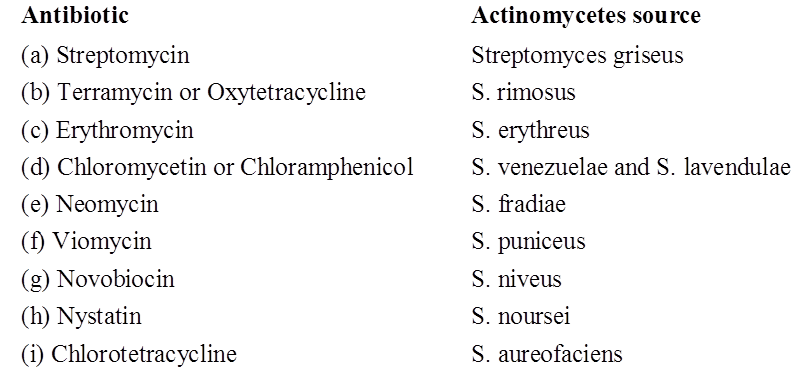
Frankia can fix N2 symbiotically by root nodule formation in non legumes like -Alnus, Myrica and Casuarina.
Earthy or musty smell of freshly ploughed soil or soil after first shower of rain, is due to oily secretion geosmin by some members like Nocardia, Micromonospora and Streptomyces
Concept Builder
1. In 1798, Edward Jenner used cowpox virus for immunising people against small pox.
2. Pasteurization simply kills bacteria but does not sterilize milk. It frees the latter of all vegetative cells of pathogens, but not the endospores.
3. Mycobacterium and Xanthomonas form nodules in leaves of Ardisia, Pavetta.
4. Bacterial cell membrane contains pentacyclic sterol like molecule termed as hopanoids as membrane stabiliser.
5. Kleinberger discovered tuberculosis and anthrax bacteria & developed "L-form" bacteria.
6. H. T. Ricketts described some new types of organisms (now considered a type of bacteria) in the blood of victims of Rocky Mountain spotted fever and similar organisms were called Rickettsiae, in honour of Ricketts. They occur as obligate intracellular parasites. The Q fever is caused by Coxiella burnetti. Rocky mountain fever is caused by Rickettsia rickettsii.
7. Chlamydiae: They are obligate intracellular parasite of vertebrates. They reproduce by elementary bodies. They do not have their own ATP generating system and obtain this energy from host. So that they are called energy parasite.
- Diseases
- Trachoma (eye disease) – C. trachomatis
- Conjuctivitis – C. trachomatis
- Psittacosis (influenza like) – C. psittaci
8. Joseph Lister developed the technique of aseptic cultures.
9. Nostoc develops symbiotic associations with Gunnera stem and Trifolium roots.
Kingdom: Monera
Kingdom Monera
Monera is a biological kingdom that is solely made up of prokaryotes. Their DNA is not enclosed within the nucleus as these single-celled organisms lack a true nucleus. The Monerans also do not possess any membrane-bound organelles.
The Kingdom Monera is made up entirely of bacteria. They are the most common microorganisms on the planet. Bacteria can be found practically anywhere. A handful of soil contains hundreds of bacteria. They also exist in harsh environments like hot springs, deserts, snow, and deep oceans, where only a few other species can survive. As parasites, many of them live in or on other organisms.
The spherical Coccus (pl.: cocci), the rod-shaped Bacillus (pl.: bacilli), the comma-shaped Vibrium (pl.: vibrio), and the spiral Spirillum are the four types of bacteria classified by their shape.
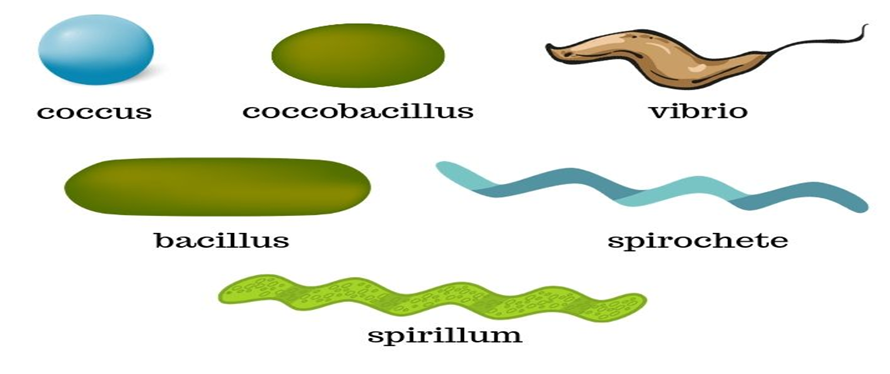
Although bacteria have a simple structure, their activity is extremely sophisticated. Bacteria, in comparison to many other creatures, have the greatest metabolic diversity.Some bacteria are autotrophic, meaning they produce their own nourishment from inorganic sources. They can be either photosynthetic or chemosynthetic autotrophs. The great majority of bacteria are heterotrophs, meaning they feed on dead organic matter or other species. Archaebacteria, Eubacteria, and Cyanobacteria are the three sub-kingdoms of the kingdom Monera.
A. Archaebacteria:
These bacteria are unique in that they survive in extremely salty environments (halophiles), hot springs (thermoacidophiles), and marshy environments (methanogens). Archaebacteria vary from other bacteria in that they have a unique cell wall construction that allows them to survive in harsh environments. Methanogens are bacteria that live in the guts of ruminant animals like cows and buffaloes and are responsible for the creation of methane (biogas) from their feces.
B. Eubacteria:
"True bacteria" is another name for Eubacteria. The existence of a hard cell wall and, if motile, a flagellum distinguishes them. A few bacteria have pili, which are small appendages on the cell surface that aid the bacterium in sexual reproduction. Pili also aids in the attachment of pathogens to their hosts. Depending on the type of the cell wall and the stain they take, they are classified as gram-positive or gram-negative.
C. Cyanobacteria:
Cyanobacteria are photosynthetic autotrophs with chlorophyll similar to green plants. They are unicellular, colonial, or filamentous algae that can be found in freshwater, marine, or terrestrial environments. Gelatinous sheath surrounds the colonies in general. Blooms are common in contaminated water bodies. Some of these species, such as Nostoc and Anabaena, can fix atmospheric nitrogen in specialized cells called heterocysts. Chemosynthetic autotrophic bacteria utilize the energy released by oxidizing inorganic compounds like nitrates, nitrites, and ammonia to produce ATP. They are vital in the recycling of nutrients such as nitrogen, phosphorus, iron, and sulfur.
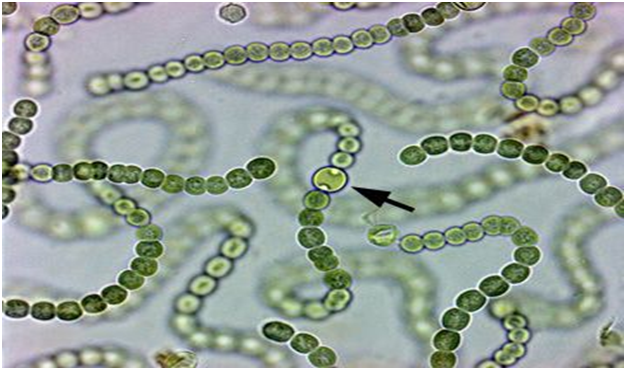
In nature, heterotrophic bacteria are the most common. The majority of them are significant decomposers. Many of them have a major influence on human affairs.They aid in the creation of curd from milk, the manufacture of antibiotics, and the fixation of nitrogen in legume roots, among other things. Some of these are infections that harm humans, crops, farm animals, and pets. Bacterial infections such as cholera, typhoid, tetanus, and citrus canker are well-known. Bacteria mostly reproduce through fission. They may generate spores in unfavorable conditions. They also reproduce by adopting a rudimentary method of DNA transfer from one bacteria to the next, which is similar to sexual reproduction.
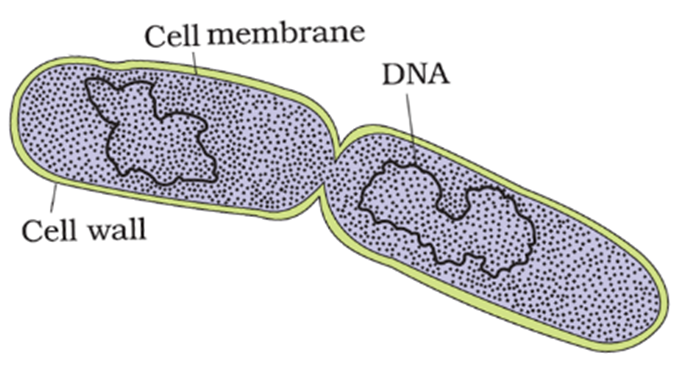
Mycoplasma are creatures that lack a cell wall entirely. They are the world's tiniest living cells, capable of surviving without oxygen. In animals and plants, many mycoplasmas are pathogenic.
Kingdom: Protista
- Books Name
- ACME SMART COACHING Biology Book
- Publication
- ACME SMART PUBLICATION
- Course
- CBSE Class 11
- Subject
- Biology
KINGDOM : PROTISTA
All unicellular eukaryotes, irrespective of their mode of nutrition, are included in the kingdom Protista in Whittaker's system. The term protista was coined by Ernst Haeckel. This kingdom forms a link between kingdom Monera on one hand and other three kingdoms i.e. , Plantae, Fungi and Animalia on the other hand. Protistans are ancestors of all multicellular eukaryotes (plants, fungi and animals).
Kingdom Protista includes

General Characteristics of Protista
1. Unicellular, eukaryotic organisms. Some are colonial without much cellular differentiation. Organisation at tissue level is absent.
2. Mostly aquatic organisms.
3. Cell structure is eukaryotic type having all kinds of membrane bound organelles and 80 S cytoplasmic ribosomes and cells may possess cellulosic cell wall.
4. Flagella and cilia have (9+2) pattern of microtubule organization consisting of tubulin protein.
5. Movement by pseudopodia, flagella or cilia where ciliary mode is fastest.
6. Mode of nutrition may be photosynthetic (holophytic), holozoic (ingestive), saprobic or parasitic (absorptive). Some have mixotrophic nutrition (photosynthetic and saprobic) as in Euglena.
7. Reproduction occurs by asexual and sexual means.
8. Life cycle is of 2 types-(i) Showing zygotic meiosis (ii) Showing gametic meiosis.
9. These are decomposers, photosynthetic or parasites. Parasitic protists may cause diseases like dysentery, malaria, sleeping sickness etc.
Photosynthetic protists and Slime moulds are described below:
(1) Photosynthetic Protists
These are popularly called protistan algae. Protistan algae constitute the major portion of the phytoplanktons.
A. Diatoms
Diatoms are golden brown photosynthetic protists and are called Chrysophytes (including both diatoms and desmids). They are both aquatic and terrestrial. Some are marine. They support much of marine life. Their important characters are
These are microscopic organisms possessing varying colours.
They are basically unicellular, but may form pseudofilament and colonies, lacking flagella except in the reproductive stage. They may be free floating (phytoplanktonic) due to presence of light weight lipids.
The cellulosic cell wall is impregnated with silica to form transparent siliceous shell, known as frustule. Depending upon the symmetry, diatoms may be pennate type, having bilateral symmetry (e.g., Navicula) and centric type, having radial symmetry (e.g., Melosira).
The cell wall is characteristic, made up of two halves; one half covering the other (epitheca over hypotheca) resembling a soap box.
The cell wall encloses the peripheral layer of cytoplasm (primordial utricle) surrounding a large central vacuole.
Nucleus lies in the central vacuole, suspended with the help of cytoplasmic strands.
Mode of nutrition is holophytic (photoautotrophic), photosynthetic pigments are chlorophyll a, chlorophyll c, b-carotene and special carotenoids containing fucoxanthin; xanthophylls like diatoxanthin, diadinoxanthin.
The reserve food is oil and a polysaccharide called leucosin (chrysolaminarin), volutin granules are also present.
They are responsible for almost 50% of the total organic matter synthesized in the biosphere.
Movement occurs by mucilage propulsion.
They mainly undergo asexual reproduction. The common mode of asexual reproduction is binary fission.
During binary fission, one half of the cell wall is retained by each of the daughter cells formed. The other half of the cell wall is secreted afresh.
Resting spores are called statospores (centric diatoms).
They reproduce sexually as well. Sexual reproduction varies from isogamy to oogamy. It involves gametic meiosis as diatoms are generally diploid (diplontic life cycle).
Concept Builder
1. Silica shells of dead diatoms are nearly indestructible and thus, get accumulated at the sea bed. Such huge rock-like deposits of hard shells of diatoms constitute diatomaceous earth, which is mined to obtain a whitish powder called diatomite or kieselguhr or diatomaceous earth. Diatomite is rough and gritty. Because of these features, it is used in filters in brewing industry, sugarcane refineries, in polishes for metals, tooth pastes, for making insulating bricks, in insulation of refrigerators, houses and for making the latter sound proof, in the manufacture of dynamite, water glass or sodium silicate and strong acids. This is added to paint to increase their night visibility.
2. They are very good indicators of water pollution. Common examples of diatoms are Triceratium, Melosira, Navicula, Cymbella.
B. Dinoflagellates
Dinoflagellates are golden brown photosynthetic protists, belonging to class Dinophyceae (Pyrrophyta). They are mainly marine, though few are fresh water forms.
They may appear red, yellow, green, brown or blue depending upon the main pigment present in cell.
General characters :
Unicellular, motile, biflagellate, golden brown photosynthetic protists (some are non-motile, amoeboid, palmelloid or filamentous).
They are mostly marine, some are found in fresh water.
The body is enclosed by a rigid coat called theca or lorica consisting of 2 to many articulated or sculptured plates of cellulose and pectin , hence are also called armoured dinoflagellates.
Theca has generally two grooves i.e., longitudinal called sulcus and transverse called cingulum or annulus or girdle.
Flagella are heterokont (different). One is longitudinal and other is transverse. The flagella pass out through the pores in the lorica and lie in the grooves. The transverse flagellum lies in the circular groove and the longitudinal flagellum in the longitudinal groove. The longitudinal flagellum is narrow, smooth directed posteriorly and the transverse flagellum is ribbon like
Both are oriented at right angle to each other producing spinning movements. Therefore, these protists are also called 'whirling whips'.
Most of the species have brown, green or yellow chromatophores with chlorophyll a, c, a-carotene, xanthophyll (e.g., Peridinin). Plastids are generally surrounded by 3-membrane envelope and contain 3-thylakoid lamellae. They are autotrophic or photosynthetic (Ceratium), a few are saprobic or parasitic.
Reserve food is carbohydrate and oils.
Nucleus is relatively larger in size, has condensed chromosomes even in interphase, chromosomes do not have histone. Nuclear envelope and nucleolus remain present even during cell division. This organisation is called Mesokaryon (Dodge, 1966).
A non-contractile vacuole called pusule is present near the flagellar base. It may have one or more vesicle and takes part in floatation and osmoregulation.
Some dinoflagellates possess trichocysts and cnidoblasts like those of coelentrates.
Reproduction is commonly asexual and occurs through cell division.
Isogamous and anisogamous sexual reproduction is reported from some dinoflagellates
e.g., Ceratium.
Life cycle involves zygotic meiosis (Ceratium, Gymnodinium). Gametic meiosis occurs in Noctiluca.
Concept Builder
1. Some marine dinoflagellates show bioluminescence, i.e., emit light, e.g., Noctiluca, Pyrodinium, Pyrocystis. Due to phosphorescence the sea glows at night.
2. Some dinoflagellates like Gonyaulax catenella produce a toxin called saxitoxin into the sea water which is highly poisonous to vertebrates, e.g., fishes and other aquatic animals. Marine shell fish consume dinoflagellates and accumulate the poison which is not harmful to the shell fish (mussel) but upon being consumed causes severe illness in man called paralytic shell fish poisoning (PSP) and even prove fatal.
3. Some dinoflagellates proliferate in large number and cause red tide of the sea, e.g., Gonyaulax, Gymnodinium.
C. Euglenoid (Euglena-like)
It is a group of chlorophyllous and non chlorophyllous flagellate protists. Largest genera being Euglena amongst them.
Euglenoids are unicellular, flagellate protists found in water or damp soil. Majority of them are fresh water organisms found in stagnant water.
Body is spindle shaped with blunt anterior end and pointed posterior end.
Cell wall is absent but a covering periplast or pellicle is present which is proteinaceous (elastic) in structure.
Locomotory organs are flagella.
The cell bears a single long tinsel type flagellum (stichonematic) arising at the anterior end. Actually, there are two flagella but one of these is reduced. The longer flagellum has two branches at the base each having its own basal granule. In the area of union of two flagella is present a photosensitive paraflagellar body.
Myonemes are oblique but parallely arranged strips in pellicle. Euglenoids perform creeping movement of contraction and expansion with the help of myonemes which is called metaboly or euglenoid movement.
The apical end of the cell bears an invagination with three distinct parts, i.e., mouth (cytostome), canal (gullet or cytopharynx) and reservoir. It helps in the ingestion of solid food particles.
Stigma or an eye spot is attached to the membrane of the reservoir at the level of paraflagellar body and along with it seems to be involved in perception of light stimulus. It contains photosensitive red-orange pigment called astaxanthin.
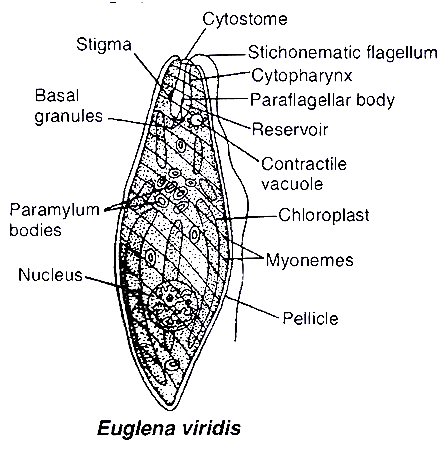
A contractile vacuole occurs in the anterior end of the cell just below the reservoir, meant for osmoregulation and excretion.
Single large nucleus lies near the centre of the protoplast.
Nutrition in Euglena viridis is photoautotrophic. However, it is capable of getting nourishment from dead and decaying organic matter in the substrate by secreting digestive enzymes (saprophytic nutrition) in the absence of light. This dual mode of nutrition is termed as mixotrophic. Holozoic nutrition is absent in Euglena. Some forms are holozoic (Paranema) or saprobic (Rhabdomonas).
Photosynthetic pigments are chlorophyll a, chlorophyll b, xanthophyll and b-carotene.
Reserve food material is paramylon, stored in cytoplasm in the form of paramylum granules. They are chemically b 1,3-glucans.
Under favourable conditions, they mainly reproduce by longitudinal binary fission. During unfavourable conditions, palmella stage and cysts are formed for perennation. Sexual reproduction is not known to occur in euglenoids, e.g., Euglena and Paranema.
Concept Builder
1. Euglena is producer-decomposer protist.
2. It is studied as plant as well as animal and is called as plant animal.
3. Plant characters of Euglena:
- Presence of chloroplast with photosynthetic pigments.
- Holophytic nutrition
4. Animal characters of Euglena:
- Absence of cell wall and presence of proteinaceous pellicle.
- Presence of stigma and paraflagellar body.
- Presence of contractile vacuole.
- Presence of longitudinal binary fission.
(2) Slime moulds or consumer-decomposer protists
They were included in class myxomycetes of fungi in two-kingdom classification. They were called mycetozoa by DeBary as they are closely related to animals. Mycologists include them in gymnomycota. Because of their nature they are called protistan fungi.
General characteristics of the slime moulds are :
They are usually free-living, creeping over debris like fallen leaves and rotting logs of wood.
They have naked protoplast, not covered by any cell wall in vegetative stage.
They lack chlorophyll and have saprobic or phagotrophic mode of nutrition.
During life cycle they are amoeboid and non-cellulosic, but spores have cellulosic wall so that their vegetative phase resembles with animals while reproductive phase resembles with plants.
Amoeboid plasmodial stage resembles protozoa and spore forming nature is like fungi.
Spores are extremely resistant and survive for many years, even under adverse conditions. The spores are dispersed by air currents.
Reproduction is both asexual and sexual. This group is represented by two separate types of organisms i.e. acellular and cellular.
A. Acellular or Plasmodial slime moulds
General characters:
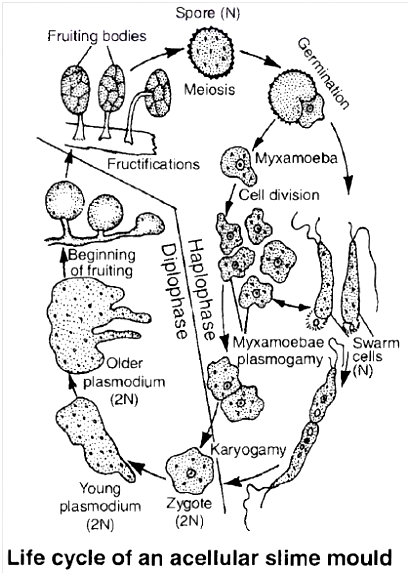
Slimy masses found on decaying leaves and lumber.
Somatic body is free living, multinucleate, naked, diploid mass called Plasmodium. Movement occurs by means of pseudopodia.
During unfavourable conditions, entire plasmodium forms many fructifications/fruting bodies (polycentric). The fruiting body is called sporocarp which contains a stalk having a sporangium at its tip. The wall of sporangium is called peridium.
Sporangium has an intricate network of cytoplasmic threads called capillitium.
DiploId protoplast forms haploid spores by meiosis.
Spore wall is double, outer wall is spiny and sculptured.
On germination, spores produce biflagellate swarm cells or non-motile myxamoebae which act as gametes.
Sexual reproduction is isogamous.
Diploid zygote directly forms the plasmodium which becomes multinucleate by repeated mitotic divisions of the diploid nucleus.
Chief mode of nutrition is saprotrophic.
Vegetative reproduction is by fission .
e.g., Physarum, Physarella, Fuligo, Dictydium, Lycogala
B. Cellular slime moulds or communal slime moulds
General characters :
Wall less, uninucleate myxamoebae present. Complete absence of flagellated cells during life cycle.
Formation of pseudoplasmodium stage as a result of chemotactic movement of myxamoebae due to release of cAMP and acrasin.
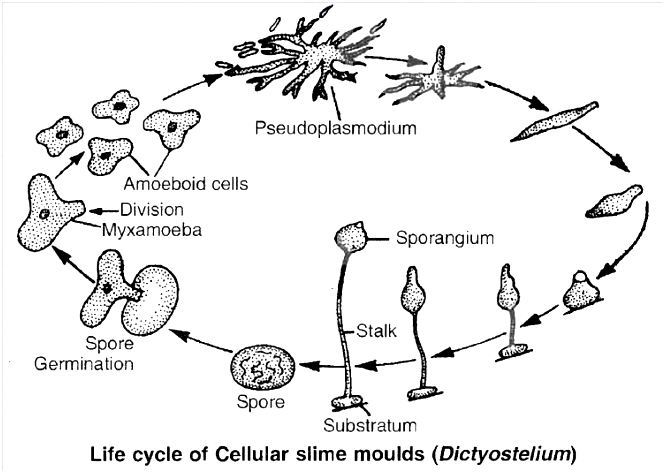
Sporangia are naked.
Spores have cellulosic wall.
Sexual reproduction is anisogamous.
Common cellular slime mould, Dictyostelium, is a colonial form in which hundreds of uninucleate, haploid amoeboid cells are aggregated without any fusion to form a colony.
The colony gives the appearance of single multinucleate mass of protoplasm and thus, called pseudoplasmodium.
Under exhausted food supply and stimulation by cAMP and chemical acrasin, many cells come close together by chemotactic movement during the formation of pseudoplasmodium.
Pseudoplasmodium exhibits primitive form of multicellularity and division of labour.
So these are also called as communal slime moulds.
On these basis cellular slime moulds are regarded as advanced protists and primitive fungi.
During unfavourable conditions, the myxamoebae may form a cyst called microcyst for perennation and dispersal.
Under dry conditions, the pseudoplasmodium produces stalked sporocarp, which may be branched or unbranched, each branch bearing single sporangium terminally (monocentric).
Sporangium is wall less. Within the sporangium, amoeboid cells become rounded to secrete a spore wall around.
On the approach of favourable conditions, spores are liberated.
Each spore germinates by rupturing cellulosic wall to form myxamoeba and the myxamoebae may live independently, multiply by repeated mitotic divisions or get aggregated to form pseudoplasmodium.
Sexual reproduction is anisogamous type. During sexual reproduction, a number of myxamoebae form a clump.
One of the myxamoeba becomes larger and engulfs the surrounding smaller myxamoebae.
The plasmogamy occurs and the fused protoplast secretes a thick wall around to form macrocyst.
In the macrocyst, karyogamy occurs and it thus, becomes zygote.
It is followed by meiosis and several mitotic divisions to form a large number of haploid myxamoebae, which are released by rupture of macrocyst wall.
- e.g., Dictyostelium, Polysphondylium.
Kingdom: Protista
Kingdom Protista
Kingdom Protista is a diverse group of organisms. It includes all eukaryotes that aren't animals, plants, or fungi, including single-celled and multicellular creatures. There are an estimated 60,000 to 200,000 protist species, with many more yet to be discovered. Apart from a relatively simple organization, the eukaryotes that make up this kingdom have little in common. Some protists are small and unicellular, like an amoeba, while others, like seaweed, are enormous and multicellular. Multicellular protists, on the other hand, lack highly specialized tissues and organs. Protists are distinguished from other eukaryotes, such as fungi, mammals, and plants, by their basic cellular arrangement. Protista is largely an aquatic phylum. This kingdom is linked to the kingdoms of plants, animals, and fungus.
The Protista cell body, like other eukaryotes, has a well-defined nucleus and other membrane-bound organelles. Some have flagella or cilia, while others don't. Cell fusion and zygote development are used by protists to reproduce both asexually and sexually. Many protists, such as algae, are photosynthetic and play an important role in ecosystems as primary producers. Other protists cause a variety of deadly human diseases, including malaria and sleeping sickness.Chrysophytes, Dinoflagellates, Euglenoids, Slime molds, andProtozoans come under Protista.
A. Chrysophytes:
Diatoms and golden algae (desmids) are members of this category. They can be found in both freshwater and marine habitats. They are tiny and float on water currents passively (plankton). They are mostly photosynthetic. The cell walls of diatoms produce two thin overlapping shells that fit together like a soapbox. Because the walls are embedded with silica, they are unbreakable. As a result, diatoms have left behind a vast amount of cell wall deposits in their habitat, which has been referred to as 'diatomaceous earth' over billions of years. Because this soil is rough, it is utilized for polishing and filtration of oils and syrups. In the oceans, diatoms are the primary 'producers.'
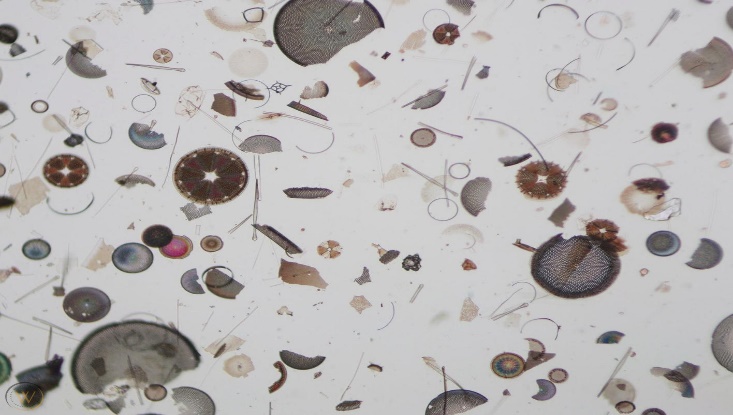
B. Dinoflagellates:
These organisms are mostly marine and photosynthetic.They appear yellow, green, brown, blue, or red dependingon the main pigments present in their cells. The cell wallhas stiff cellulose plates on the outer surface. Most ofthem have two flagella; one lies longitudinally and theother transversely in a furrow between the wall plates.Very often, red dinoflagellates (Example: Gonyaulax)undergo such rapid multiplication that they make thesea appear red (red tides). Toxins released in such largenumbers may even kill other marine animals such as fish.

C. Euglenoids:
The majority of them are freshwater organisms found in stagnant water. Instead of a cell wall, they have a protein-rich layer called pellicle which makes their body flexible.They have two flagella, a short and a long one. Thoughthey are photosynthetic in the presence of sunlight, whendeprived of sunlight they behave like heterotrophs bypredating on other smaller organisms. Interestingly, thepigments of Euglenoids are identical to those present in higher plants. Example: Euglena.
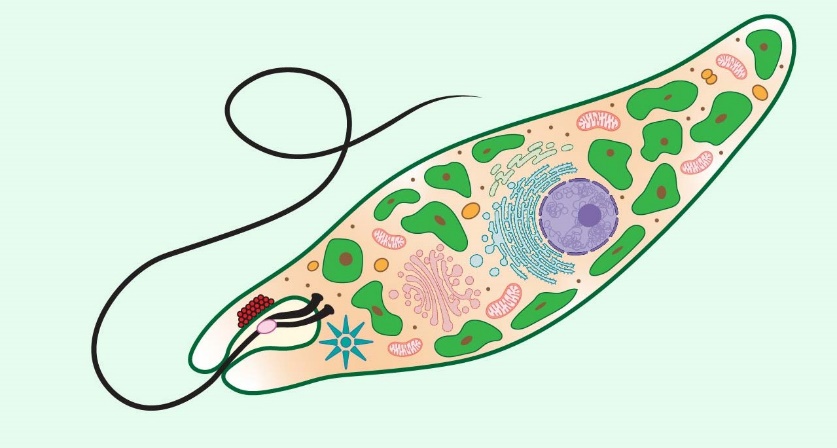
D. Slime Molds:
Slime molds are protists that feed on their surroundings. The organism eats organic matter as it glides along with rotting twigs and leaves. They create a plasmodium, which can grow and spread over severalfeet if the conditions are right. The plasmodium develops and generates fruiting bodies with spores at their tips in unfavorable conditions. True walls exist within the spores. They are highly hardy and may live for many years in harsh environments. Air currents disseminate the spores.
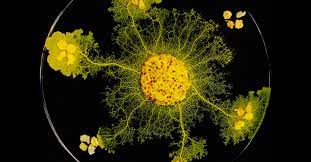
E.Protozoans:
They are all heterotrophic organisms that exist as predators or parasites. Animal relatives are thought to be their ancestors. Protozoans are divided into four categories.
1. Amoeboid protozoans dwell in freshwater, seawater, or moist soil. As in Amoeba, they move and seize their prey by putting out pseudopodia (false feet). Silica shells cover the surface of marine organisms. Some of them are parasites, such as Entamoeba.
2. Flagellated protozoans: This group includes both free-living and parasitic protozoans. They have flagella on their bodies. Sleeping sickness is caused by a flagellated parasitic protozoan. Trypanosoma is a good example.
3. Ciliated protozoans: Ciliated protozoans are aquatic, actively moving organisms with thousands of cilia. They have a cavity (gullet) on the cell surface that opens to the outside. The water-containing food is directed towards the gullet by the coordinated movement of rows of cilia. Paramoecium is a good example.
4. Sporozoans: This term refers to a group of organisms that have a spore-like stage in their life cycle. Plasmodium (malarial parasite), which causes malaria, is the most well-known. Malaria is a disease that has a devastating impact on the human population
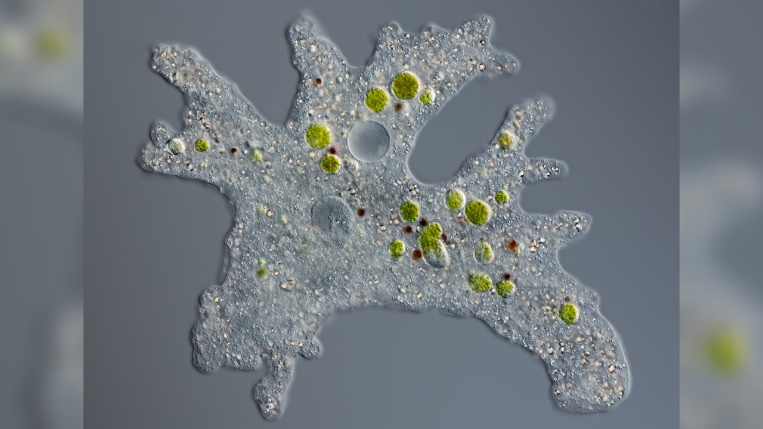
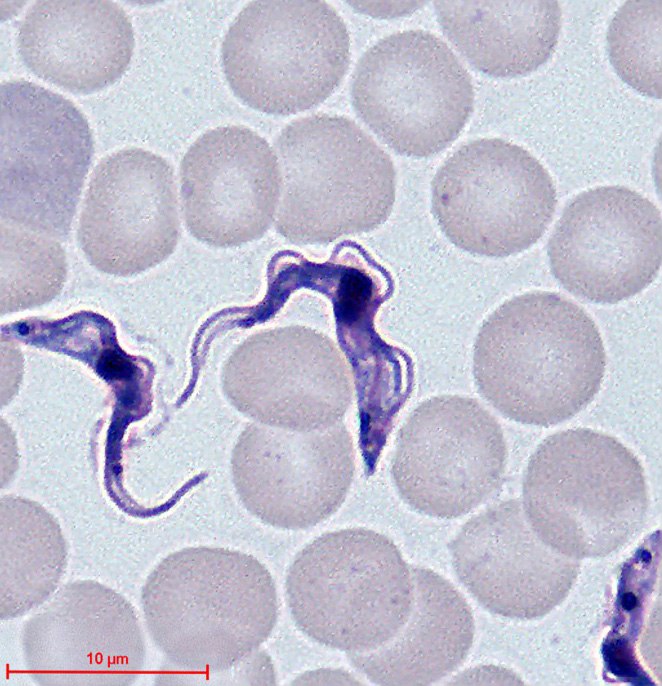
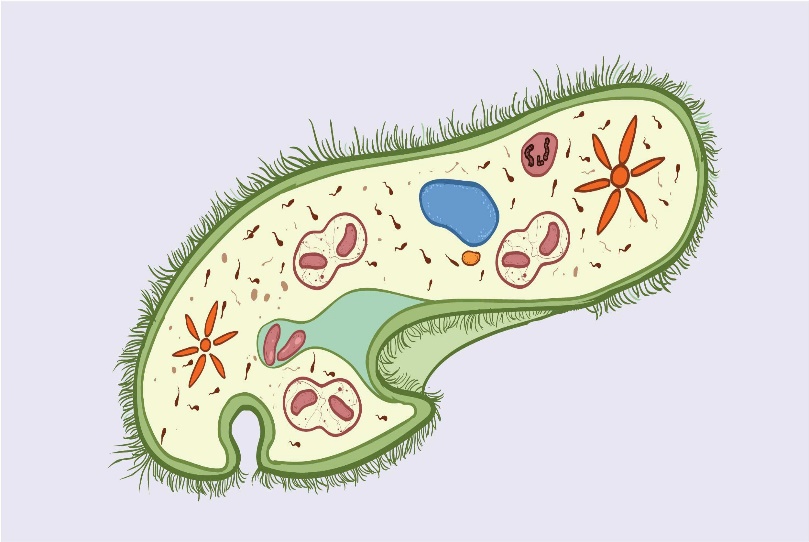
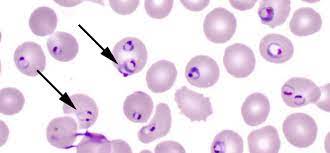
Figure 8 (a) Ameoba (b) Trypanosoma (c) Paramecium (d) Plasmodium
Kingdom: Fungi
- Books Name
- ACME SMART COACHING Biology Book
- Publication
- ACME SMART PUBLICATION
- Course
- CBSE Class 11
- Subject
- Biology
KINGDOM : FUNGI
This kingdom contains achlorophyllous, eukaryotic, heterotrophic, spore producing, thalloid organisms. The study of fungi is called mycology.
Pier Antonio Micheli is considered as father or founder of mycology.
Mycologist H.A. de Bary is the father of modern mycology.
The father of Indian mycology is E.J. Butler.
General Characters
They are cosmopolitan and occur in air, water, soil and on animals and plants. They are mostly terrestrial. They prefer to grow in warm and humid places.
They may grow on tree bark, dung, wood, burnt wood and keratinous material (e.g., hair, horns) and are called corticolous (bark), coprophilous (cow dung), epixylic (wood), xylophilous (burnt wood) and keratinophilous (keratin) respectively.
The body is haploid (n) and thalloid, i.e., not differentiated into root, stem and leaves. They are multicellular (except Yeast and Synchytrium).
The fungal body is made up of thread like elongated tubular structures, called hyphae. These cris-cross with one another to form a network known as mycelium.
The hyphae may be aseptate and multinucleate. Such a hypha is termed coenocytic. In most of the fungi, the mycelium is septate.
The septum, however, is not complete, but has a pore through which continuity of the cytoplasm of the adjoining cells is maintained.
The septum may have simple central pore as in ascomycetes, but in higher fungi (class basidiomycetes), the septum is dolipore septum, in which central pore possesses a barrel shaped inflation.
In septate mycelium, individual cell may contain single nucleus (monokaryotic -feature of primary mycelium) or an intermediate phase of two nuclei (dikaryotic -feature of secondary mycelium).
The cell wall of the hyphae is made up of chitin or fungal cellulose, which is a polysaccharide containing nitrogenous compound and it is basically made up of acetylglucosamine.
In some fungi, the cell wall is made up of cellulose (e.g., Phytophthora, Pythium and other oomycetes). Reserve food material is stored in the form of oil and glycogen.
Cells have unicisternal golgi bodies.
Mitosis in somatic cells is Karyochorisis type (mitosis with intranuclear spindle formation).
Nutrition is heterotrophic which includes saprophytes, parasites and symbionts.
In most of the fungi, there are two distinct phases in the life cycle, the vegetative or assimilative phase and the reproductive phase.
In vegetative phase, fungus is microscopic hidden in the substratum and is hardly visible to the naked eyes.
The fungus enters into reproductive phase after attaining maturity in the vegetative phase.
In unicellular yeasts, the same cell performs both assimilative and reproductive functions.
Such type of fungal bodies in which entire cell gets transformed into reproductive structures are known as holocarpic.
Fungal body is termed eucarpic in which a part of mycelium is used up in the development of reproductive structures.
Concept Builder
Modification of mycelium:
(a) Plectenchyma :
When hyphae of a mycelium grow together like plates and intertwine with one another forming a thick woven structure, it is called plectenchyma.
Plectenchyma may have :
(i) Prosenchyma : Loosely interwoven structure whose hyphal components lie more or less parallel to each other and are recognizable.
(ii) Pseudo parenchyma : Hyphae are compactly arranged and hyphal components have lost their identity and appear isodiametric and continuous in section resembling parenchyma of higher plants.

(b) Sclerotia (Singular Sclerotium) :
In some fungi like Claviceps the mycelium may pass into a dormant or resting stage by the formation of hard resting bodies resistant to unfavourable conditions.
Each sclerotium is composed of central prosenchymatous and peripheral pseudoparenchymatous arrangement which are again surrounded by a ring of pigmented hyphae.
(c) Rhizomorph:
- When the fungal hyphae aggregate together below surface they behave as an organized unit to form a root like strand with a thick hard cortex.
- It also develops a growing tip somewhat resembling that of a root tip, e.g., Agaricus.
(d) Appressorium: Terminal swollen structure of germ tube for attachment, and penetration.
(e) Haustoria: Terminal swollen structure for absorption of food, e.g., Albugo.
(f) Snares/hyphal traps: Helps in capturing nematodes in predaceous fungi, e.g., Arthrobotrys, Dactylaria
Reproduction in Fungi
- Fungi reproduce by all the three modes, i.e., vegetative, asexual and sexual.
1. Vegetative reproduction: It occurs by the following methods:
(a) Fragmentation : The mycelium breaks up into two or more fragments due to mechanical injury, decay or some other reasons. Each fragment grows into independent mycelium.
(b) Fission: Here, simple splitting of vegetative cells into two daughter cells takes place by simple constriction.
(c) Budding: Some fungi like yeast produce small outgrowths, i.e., buds from their vegetative body. Eventually, the buds are cut off from parent cell and mature to form new individuals.
2. Asexual reproduction:
It occurs through spores.
These are single celled specialized structures which separate from the organism, get dispersed and germinate to produce new mycelium after falling on suitable substrate.
The spores produced during asexual reproduction in fungi are formed by mitotic division and are thus termed, mitospores.
The various means of asexual reproduction are as follows :
(a) Zoospore :
Many fungi, especially aquatic members produce these types of spores.
Zoospore may be uniflagellate, e.g., Synchytrium or biflagellate, e.g., Saprolegnia, Pythium and are naked uninucleate structures formed in zoosporangia.
They germinate to give rise to new mycelium.
Biflagellate zoospores are of two kinds (e.g., Saprolegnia) pear shaped or pyriform with 2 flagella placed at anterior end (primary zoospore) and kidney shaped or bean shaped, bearing two laterally inserted flagella (secondary zoospore).
This phenomenon of having two types of zoospores is called diplanetism.
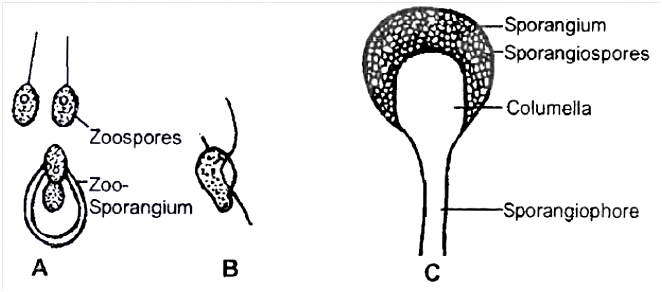
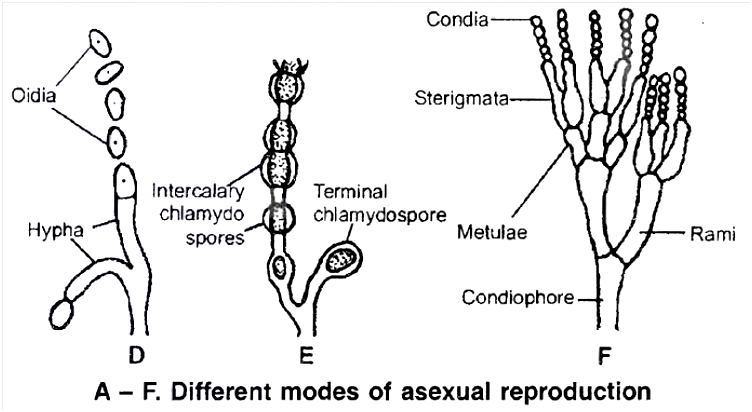
(b) Sporangiospore :
(c) Conidia:
Conidia are non motile, thin walled exogenous spores produced at the tips of erect hyphae called conidiophore.
They are arranged in chains upon the conidiophore, e.g., Aspergillus and Penicillium
(d) Chlamydospore:
In some fungi the hyphae under unfavourable conditions, forms thick walled resting resistant spores which later get separated from each other.
They may be terminal or intercalary.
They may remain viable for several years.
On return to favourable conditions they germinate to give rise to new individuals.
Thus, chlamydospores are structures for perennation also, e.g., Rhizopus.
(e) Oidia:
Non-motile thin walled spores developing under sugar rich conditions in medium.
Their budding condition is called torula stage.
3. Sexual reproduction:
Sexual reproduction is reduced in fungi and takes place by two fusing gametes.
It includes 3 stages :
(a) Plasmogamy:
There is union between two haploid protoplasts which results in bringing the fusing nuclei of different parents close together.
In some fungi, plasmogamy is immediately followed by karyogamy.
However, in Ascomycetes and Basidiomycetes, an intermediate dikaryotic (n + n) condition occurs. This phase is called dikaryophase.
(b) Karyogamy: The two haploid nuclei which come together in plasmogamy fuse and thus, a diploid zygote is produced.
(c) Meiosis: Reduction division takes place in the zygote thus, reducing the number of chromosomes to half.
Plasmogamy occurs by the following methods :
(a) Planogametic copulation / Gametic fusion:
This is the simplest form of sexual reproduction.
In this process, fusion of two gametes of opposite sex or strains takes place.
One or both of the fusing gametes are motile.
It results in the formation of a diploid zygote, e.g., Allomyces.
This process is usually of three types: Isogamy, Anisogamy, Oogamy.

(b) Gametangial contact :
In this process two gametangia come in contact with one another.
A fertilization tube is developed to facilitate the migration of entire contents of male gametangium into the female gametangium.
Both the gametangia never fuse together losing their identity, e.g., Pythium, Albugo (Oomycetes).

(c) Gametangial copulation :
In this process, direct fusion of entire contents of two gametangia is accomplished by dissolution of their common walls resulting in the formation of a single cell, in which protoplasts of two gametangia fuse, e.g., Mucor, Rhizopus (Zygomycetes).
(d) Spermatization :
Some fungi produce many minute, spore like, single-celled structures called spermatia (non motile male gametes) on spermatiophores (hyphae).
These structures are transferred through agencies like water, wind and insects to special female receptive, hyphae (Basidiomycetes).
The contents migrate into receptive structure.
Thus, dikaryotic condition is established, e.g., Puccinia.
(e) Somatogamy :
This takes place in most of the higher true fungi, where formation of gametes is absent.
In such fungi, direct fusion of somatic hyphal cells occur to establish dikaryophase, e.g., Agaricus
Classification of Fungi
A number of criteria are used for classifying fungi.
Morphology of mycelium, mode of spore formation and fruiting bodies form the basis for the classification of this kingdom.
A common systematic presentation is given below
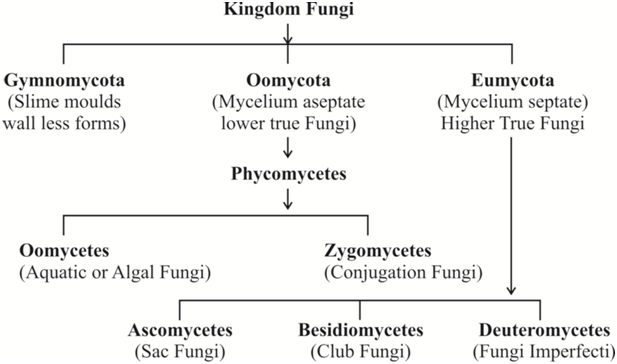
I. Oomycetes : The algal fungi
Hyphal wall contains cellulose and other glucans in many members.
The mycelium is coenocytic (multinucleate and aseptate).
Asexual reproduction involves the formation of spore containing sacs or sporangia. In aquatic forms, the sporangia produce zoospores.
Zoospores generally have two laterally inserted flagella with heterokont condition, in which one flagellum is smooth (whiplash) while the other is of tinsel type (having fine surface outgrowths called mastigonemes).
Sexual reproduction is by planogametic fusion or gametangial contact.
The product of sexual reproduction and site of meiosis is oospore.
Concept Builder
(i) Phytophthora infestans causes late blight of potato and occasionally of tomato as well. Great Irish famine of 1845 -1847 was due to late blight of potato.
(ii) Albugo candida (Cystopus candidus) causes white rust of crucifers and is characterised by the appearance of irregular white blisters on the leaves and stems.
(iii) Pythium debaryanum causes damping off disease in seedlings of tomato, chillies, castor, mustard.
(iv) Sclerospora graminicola causes downy mildew in cereals particularly, Pennisetum typhoides (vern. Bajra) green ear disease.
(v) Peronospora parasitica causes downy mildew in a number of plants, such as mustard, spinach, onion etc.
(vi) Saprolegnia causes salmon disease of gills in fishes.
II. Zygomycetes: The conjugation fungi
It is class of terrestrial fungi which are mostly saprotrophic and rarely parasitic.
Hyphal wall contains chitin or fungal cellulose.
The mycelium is coenocytic (multinucleate, aseptate) like the one found in Oomycetes.
Motile cells (zoospores or planogametes) are absent.
Mitospores are non motile. They are called sporangiospores as the spores are formed inside sporangia that are borne at the tips of special hyphae called sporangiophores.
Sexual reproduction occurs through gametangial copulation or conjugation. Because of it, zygomycetes are also called conjugation fungi.
The gametes are commonly multinucleate and are called coenogametes.
Sexual reproduction produces a resting diploid spore called zygospore. Because of the presence of zygospore, the group of fungi is called zygomycetes. Zygospore differs from oospore in that, for its formation a distinct food laden, non motile, large female gamete is not produced.
Zygospore is the site of meiosis and does not give rise to new mycelium directly. Instead it produces a new sporangium called germ sporangium (previously called zygosporangium). Germ sporangium forms meiospores called germ spores.
Sometimes, gametangia fail to fuse. Gametangia become surrounded by a thick wall resulting in formation of azygospore (parthenogenetically produced zygospore).
Concept Builder
(i) Rhizopus stolonifer (= R. nigricans) is popularly known as black bread mould. Mucor mucedo is called dung mould or pin mould. Rhizopus and Mucor are the common saprotrophic fungi that attack a variety of food stuffs. Soft rot or leek disease of strawberry, apple, jack fruit, sweet potato etc. is due to Rhizopus. Mucor pusillus causes infection of internal organs in human beings. Absidia corymbifera causes bronchomycosis.
(ii) Ramysin (antibiotic) is obtained from Mucor ramannianus.
Life Cycle of Rhizopus
Rhizopus is a saprophytic fungus, commonly found on dead organic matter rich in carbohydrates.
Mycelium is made up of white narrow thread like hyphae growing on the surface of substratum.
Two types of vegetative hypha (Rhizoidal and Stoloniferous) arise from definite points called hold fast / apparent nodes.
Third hypha is asexual, called Sporangiophore and fourth type is sexual hypha called zygophore.
The absorptive hyphae are called rhizoidal hyphae which penetrate into the substratum.
The hyphae appeared over the surface of substratum are in the form of stolons.
From the nodes of stolons arise branched rhizoidal hyphae on the under surface and a group of aerial structures called sporangiophore (asexual hypha) from the upper surface of 'apparent nodes'.
The apical portion of each sporangiophore ends into a swollen structure called sporangium which is filled with spores.
The hyphae are coenocytic, aseptate and branched. It has many nuclei, oil drops, glycogen bodies and vacuoles in the cytoplasm.
The reproduction in Rhizopus is vegetative, asexual and sexual.
- Vegetative reproduction: This takes place by fragmentation of hyphae.
- Asexual reproduction :
Asexual reproduction takes place by the formation of non-motile spores inside a sporangium.
The tip of aerial hypha swells in which cytoplasm migrates with nuclei.
The tip swells considerably and the nuclei divide repeatedly.
The contents of the young swollen tip differentiate into a central zone called columellaplasm mainly filled with vacuolated cytoplasm surrounded by a peripheral zone called sporangioplasm containing dense cytoplasm and many nuclei.
Vacuoles ultimately form a continuous vacuolated layer by fusing laterally one after the other and ultimately develop into a dome shaped septum known as columella (sterile part).
In the meantime, cleavage of sporangioplasm takes place resulting into innumerable, small 2-10 nucleate portions which round up, become invested with spore membranes, and develop into nonflagellate spores, the sporangiospores.
These are formed under most favourable conditions. Thus, the sporangium is large, globose and contains many spores.
Spores are dispersed by bursting of the thin wall of the sporangium due to pressure that is set up in the columella.
Other two asexual spores are oidia and chlamydospores (formed under unfavourable conditions).
The spores on germination produce a germ tube giving rise to new mycelium.
3. Sexual Reproduction :
Sexual reproduction in Rhizopus takes place by the formation of two multinucleate gametangia.
Both the gametangia are similar externally but are different physiologically i.e. they are of (+) and (-) type.
It is called heterothallism (This was discovered by Blakeslee in Rhizopus stolonifei ).
Another species called Rhizopus sexualis is a homothallic species.
When two mycelia of opposite strains, (+) behaving as male and (-) behaving as female respectively, come near one another, under influence of a chemical called trisporic acid, this stimulates the formation of special sub-aerial hypha called zygophores.
This hypha produces small outgrowths, called progametangia.
Their apical ends are swollen and filled with multinucleate protoplasm.
This apical portion of these progametangia, comes in contact with one another.
A septum is laid down, separating the terminal portion which is now termed gametangium. The remaining part of progametangia is called suspensor.
The multinucleate undifferentiated protoplast of each gametangium is termed as coenogamete.
As the gametangia mature, the separating wall dissolves from the middle to outward and intermingling of the contents of two gametangia takes place (Gametangial copulation).
Nuclear pairing and fusion of one (+) and another (-) nuclei gives rise to a large number of diploid nuclei.
The young zygospore lying within the parent gametangial wall enlarges considerably and secretes several layers of thick wall (5 layered, 2 layered exosporium and 3 layered endosporium) around it.
The zygospore matures it breaks up the original gametangial wall into small pieces that fall apart exposing the outer thick, spiny and black exosporium.
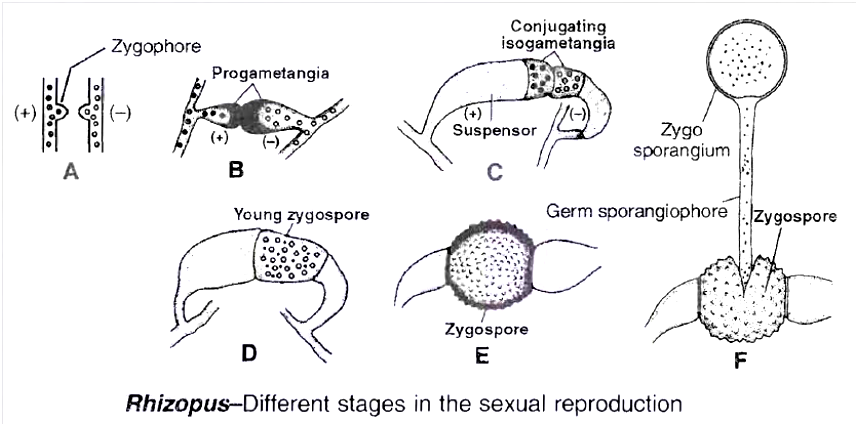
Meiosis occurs at the time of germination of zygospore.
The zygote germinates after rest period.
On germination, the exosporium cracks and endosporium produces a germsporangiophore (promycelium) that terminally develops a germ sporangium (zygosporangium) which bears large number of spores.
The meiosis produces 4 haploid nuclei where only one remain functional.
This divides repeatedly to produce coenocytic mycelium with many haploid nuclei.
Occasionally, failure of gametangial copulation results in parthenogenetic development of zygospore, which are called azygospores (parthenospores
III. Ascomycetes: The sac fungi
The mycelium consists of septate hyphae. (Yeasts are an exception in that they are basically unicellular).
They are saprophytic, decomposers, parasitic or coprophilous (growing on dung).
The septa possess central pores called septal pores. The pores allow communication and transport between adjacent cens.
Cell wall contains chitin.
Motile structures do not occur in the life cycle.
In majority of ascomycetes, the common mode of asexual reproduction is through the formation of conidia . Conidia are borne on branched or unbranched hyphae called conidiophores , e.g., Penicillium, Aspergillus.
Female sex organ is called ascogonium.
Plasmogamy occurs by means of -
- Gametangial contact (e.g., pyronema)
- Conjugation (e.g., Yeast)
- Spermatization (e.g., Ascobolus)
- Somatogamy (e.g., Peziza)
- Autogamy (e.g., Morchella).
Karyogamy is delayed after plasmogamy. A new transitional phase appears in the life cycle. It is called dikaryophase. The cells of dikaryophase are called dikaryotic cells. Each such cell possesses two different nuclei (Dikaryon). This forms a shorter phase of life cycle.
Once a cell becomes dikaryotic, it transfers the nucleus to other cells by the crozier method (method of dikaryotization) to make them dikaryotic.
Some dikaryotic cells function as ascus mother cells. This converts the cells into asci (singular ascus). Ascus is a sporangial sac peculiar to Ascomycetes. Ascus is the site of karyogamy and meiosis. 4 to 8 haploid meiospores named ascospores are produced endogenously in each ascus. In most of the cases, half the number of ascospores belong to one mating type(+) while the other half belong to the second mating type (-).
Ascospores may be arranged linearly (Neurospora) or unorderly (yeast).
The asci may occur freely or get aggregated into specific fructifications called ascocarps. Ascocarps are of many types : cup-like (apothecium, e.g., Peziza), flask-shaped (perithecium, e.g., Neurospora, Claviceps) , elongated with a slit (hysterothecium), closed (cleistothecium , e.g., Penicillium) cushion like, chambered (Ascostroma, e.g., Pleospora). The fructifications of some ascomycetes are edible, e.g., morels, truffles.
Concept Builder
Members of this class are said to be our worst fungal enemies.
(i) Morels are Ascomycetes with edible ascocarps having fleshy sponge-like conical cap or pileus and a stalk like stipe, e.g., Morchella esculenta (vern. Guchhi), M. deliciosia.
(ii) Truffles: They are edible tuber-like subterranean ascocarps, e.g., Tuber aestivum.
(iii) Claviceps purpurea causes ergot of rye and C. microcephala causes ergot of bajra in which ears are filled with sclerotia of the fungus. Eating of infected cereals produces ergotism. (It produces an alkaloid called ergotine which causes abortion, if eaten, unknowingly). This is used as a drug to promote expulsion of foetus.
(iv) Neurospora crassa (Pink bread mould), is often employed in experimental genetics, so is called Drosophila of plant kingdom.
(v) Erisyphe: The fungus produces powdery mildew (fungal disease in which pathogen results in a powdery coating of spores on the sut1ace of the host), e.g., Erysiphe graminicola.
(vi) Penicillium chrysogenum is used in commercial production of the antibiotic penicillin. The later was the first commercial antibiotic. It was discovered from P. notatum. The fungus is employed in ripening of cheese, e.g., P.roqueforti and P. camemberti.
(vii) Aspergillus: It is common green smoky mould which not only contaminates laboratory cultures (hence called weed of laboratory), but also various food stuffs including bread, butter etc. Aspergillus flavus is highly poisonous due to the presence of aflatoxins. A. oryzae is the source of diastase enzyme.
(viii) Brewing Industry: Under anaerobic conditions, sugary solutions inoculated with yeasts are converted into alcoholic beverages, e.g., beer, wine, cider, toddy. The two common yeasts used by brewing industry are Saccharomyces cerevisiae (Beer or Baker's yeast) and S. ellipsoidens (Wine yeast).
(ix) Gibberellins: They were first discovered in the extracts of Gibberella fujikuroi growing on rice (bakanae disease of rice). It is the perfect stage of fungus Fusarium moniliforme (Deuteromycete). Gibberellins are natural plant growth hormones.
Life cycle events of (A) Yeast and (B) Penicillium are described below:
(A) Yeast
Yeasts are a group of non mycelial or pseudomycelial ascomycetes which multiply asexually by budding or fission and where asci are not organised into ascocarps.
These are facultative aerobes.
Depending upon the mode of asexual reproduction, yeasts are of three types -budding yeast (e.g., Saccharomyces), fission yeast (e.g., Schizosaccharomyces) and helobial yeast (both budding and fission, e.g., Saccharomycoides).
Yeasts in which ascus formation is known are named as true yeasts.
Related forms which resemble yeasts in main characterstics, but where ascus formation is not reported, are called false yeasts, e.g., Candida, Mycoderma, Geotrichum, Cryptococcus (false yeasts belong to deuteromycetes).
Life cycle of Yeast
It is a saprophytic fungus found on substratum which is rich in sugars, e.g., sugarcane juice, fruits (banana, plums, grapes), milk etc.
Structure
This is a circular or elliptical, unicellular, colourless fungi not having a typical mycelium.
Their cell wall contains mannans, glucans, lipids, proteins and chitin.
Protoplasm of yeast can be differentiated into two regions.
Outer region called ectoplasm in the form a thin layer and endoplasm which is granular.
The protoplasm has stored foods in the form of glycogen bodies and volutin granules and fats.
Mitochondria and ribosomes are found in the cytoplasm.
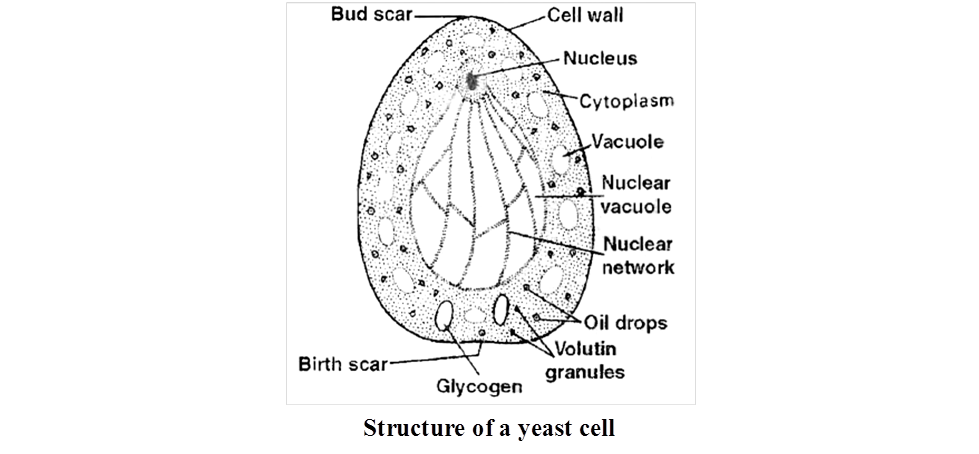
1. Vegetative Reproduction : Yeast reproduces vegetatively either by Transverse wall fission or by budding. Depending on this character, they are grouped as fission yeast (Schizosaccharomyces) and budding yeast (Saccharomyces).
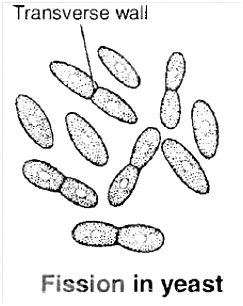
(a) By fission:
During reproduction by fission the parent cell elongates, the nucleus divides into two daughter nuclei and gradually a transverse partition wall is laid down somewhat near the middle, starting from periphery to the centre dividing the mother cell into daughter cells.
The two daughter cells so formed, may remain together for sometime and begin to divide again or they may separate soon and then divide.
(b) By budding:
Budding yeasts are rather common than the fission yeast. At the commencement of budding a small portion of the cell wall, usually near the end, softens.
The protoplast of the mother cell covered by a thin membrane bulges out in the form of a bud which ultimately develops into a daughter cell.
Meanwhile, the nucleus of the mother cell divides mitotically, (according to some, the division is amitotic).
One of the two daughter nuclei migrates into the enlarging bud.
The bud grows until it attains the size of the mother cell.
The daughter cell then becomes separated from the mother cell and the process may be repeated indefinitely.

Under conditions of rapid growth, the daughter cell also starts producing buds before being detached from the mother cell and the process may be repeated several times, giving rise to chains or groups of yeast cells.
This results in the formation of branched or unbranched pseudomycelium. The cells in chains of pseudomycelium are loosely joined together.
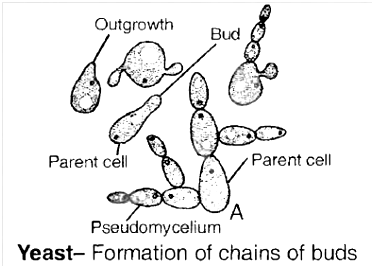
Sooner or 'A later, however, the chains break into their constituent cells.
2. Sexual Reproduction:
It takes place by the union of two cells (more often similar in size).
The copulating pair of cells may be vegetative cells or ascospores.
Yeasts may be homothallic or heterothallic and stages of fusion are extremely variable.
Three life cycle patterns are distinguishable among yeasts. These are :
(a) Haplontic life cycle: This is exhibited by Schizosaccharomyces octosporus (fission yeast).
(b) Diplontic life cycle: This is exhibited by Saccharomycoides ludwigii (Helobial yeast).
(c) Diplohaplontic life cycle: This is exhibited by Saccharomyces cerevisiae (Budding yeast).
Concept Builder
In addition to the above given methods of sexual reproduction of yeast, the following methods are also found:
- (a) Adelphogamy: Copulation between two adjoining sister cells. This is isogamous and the cells which fuse, do not separate after fission but remain united to form short chains.
- (b) Pedogamy: It is copulation between mother and the daughter cell formed by budding. The daughter remains attached to the mother and the nucleus of the bud migrates into the mother.
Saccharomyces cerevisiae = Brewer's Beer yeast or Baker's yeast
S.ellipsoidens = Wine yeast
Torulopsis utilis and Endomyces vermalis are rich in proteins. Rhodotorula is rich in vitamin A and Ashbya gossypii is rich in vitamin B2.
Yeasts are used in curing cocoa beans.
Diseases caused by yeast
(a) Candidiasis/moniliasis – Candida albicans
(b) Blastomycosis – Blastomyces dermatidis
(c) Histoplasmosis – Histoplasma capsulatus
(d) Cryptococcosis – Cryptococcus neoformans
Some yeasts reduce the yield of silk industry by attacking silkworms.
Species of Nematospora attack cotton, tomato and beans.
(B) Penicillium
Important characters
Facultative parasite and saprophytic fungi.
Mycelium is branched septate, with simple septal pore and each cell is uni or multinucleate depending upon the species.
Asexual reproduction occurs by conidia.
Conidiophores are often branched.
The first branch level is called rami and second or ultimate branches are called metulae having bottle shaped sterigmata.
Each sterigmata produces a chain of conidia.
The conidia in chain are arranged in basipetal order.
Each conidium is uninucleate, non motile, two layered, dispersed by air and germinates to form new mycelium.
Sexual reproduction: It exhibits dikaryophase and produces ascocarp.
The ascocarp is cleistothecium type.
Each ascus has 8 ascospores.
Ascospore germinates to form new mycelium.
IV. Basidiomycetes: The Club Fungi
They are the most advanced and most commonly seen fungi. Their fructifications are often large and conspicuous, e.g., mushrooms, toadstools, puff balls, bracket fungi etc.
Basidiomycetes are among the best decomposers of wood. They are able to decompose both cellulose and lignin. Lignin is not metabolised by most other fungi and even bacteria. Ganoderma species causes decay of wood even on standing trees.
Motile structures or cells are absent.
Mycelia are of two types, primary and secondary. Primary mycelium contains monokaryotic cells and is short lived.
Monokaryotic phase or primary mycelium may multiply by oidia, conidia-like spores and pycniospores.
Secondary mycelium is long lived and dominant phase of life cycle. It is represented as dikaryophase. It consists of profusely branched septate hyphae.
Septa possess dolipores or central pores with barrel-shaped outgrowths (except rusts and smuts).
Handle like outgrowths are found on the sides of septa. They are called clamp connections. Clamp connections are meant for proper distribution of dikaryons at the time of cell division.
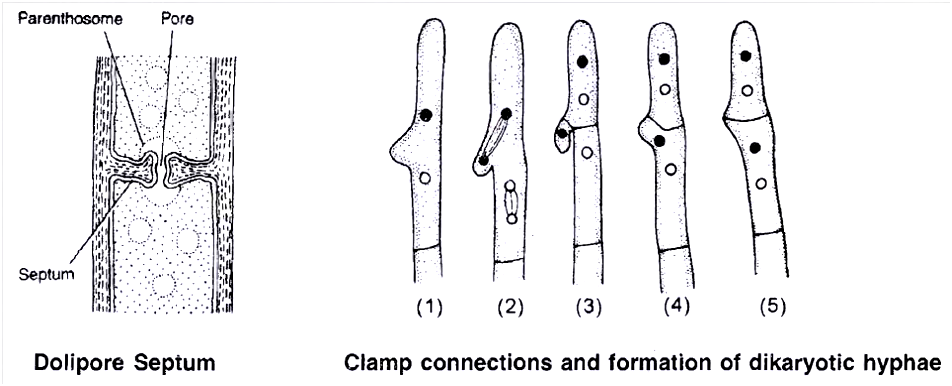
Secondary mycelium can perennate in the soil or wood by means of sclerotia or rhizomorphs.
Dikaryophase or secondary myceium may multiply by different types of spores chlamydo-spores, aecidiospores, uredospores, teleutospores etc.
There is often differentiation of two mating types (+) and (-) in thallus.
Sexual reproduction does not involve sex organs. Instead fusion occurs between basidiospores and other monokaryotic spores, between a spore or spermatium and a hypha or between two hyphal cells of primary mycelia.
Karyogamy and meiosis occur in club-shaped structures known as basidia (singular -basidium). The name of the class is based after them.
A basidium commonly produces four meiospores or basidiospores exogenously at the tips of fine outgrowths called sterigmata or directly on the basidium.
The fungi may or may not produce fructifications called basidiocarps. The basidiocarps vary from microscopic forms to large macroscopic structures. Some puff balls and brackets can be over 50 cm in diameter.
Concept Builder
(i) Smuts : They produce thick-walled, black-coloured resting spores called smut spores. Smuts are of two types, covered and loose. In covered smut, the spore mass remains within the membranous covering of sorus, e.g., Ustilago hordei (covered smut of barley), Ustilago maydis (smut of corn). In loose smut the spores are exposed while attached to the host, e.g., Ustilago nudatritici (loose smut of wheat), U. avenae (loose smut of oat).
(ii) Mushrooms : They are edible and non edible Agaricales which possess umbrella like basidiocarp. Common examples of edible mushrooms are Agaricus campestris, A. bisporous, Volvariella volvacea (Paddy straw mushroom), Pleurotus ostreatus etc.
(iii) Toadstools: Toadstools are poisonous mushrooms which generally have white spores. Amanita caesarea (Caeser's mushroom) was used in poisoning Roman emperor Caesar. The other toadstools are-Amanita phalloides (Death cup), A. muscaria (Fly agaric) and Gynomitra esculenta (heat labile carcinogenic toxin).
(iv) Rusts : They are characterised by the formation of rusty pustules containing the spores.
(a) Puccinia graminis tritici -Black rust of wheat.
(b) Puccinia glumarum or P striiformis -Yellow rust of wheat.
(c) P. recondita -Brown rust of wheat
(v) Hallucinogens: Psilocybe mexicana (Sacred mushroom) has hallucinating properties similar to LSD. It is used by Mexican Indians during certain religious ceremonies.
(vi) Armillaria (largest fungi): A. mellea (Honey mushroom) is a serious root parasite of both hardwoods and conifers. The fungus develop rhizomorphs into the phloem of the host and hence, blocks the food supply.
(vii) Puffballs: The basidiocarp is a stalked rounded structure which, upon ripening, releases out puffs of spores. The fructification may grow above or below the substratum, e.g., Lycoperdon oblongisporum, L. giganteurn.
(viii) Bracket fungi (Shelf fungi) : They are basidiomycetes whose basidiocarps or fructifications appear on tree trunks, logs, lumber etc. just as brackets or shelves, e.g., Fomes applanatus, Polyporus sulphureus, Ganoderma.
(ix) Predator fungi : e.g., Dactylaria, Arthrobotrys.
(x) Stinkhorn. Phallus impudicus (Dead man's finger). Spore mass produces a stinking odour to attract flies.
Life History of a Mushroom
Agaricus campestris is the common field mushroom which has edible basidiocarp. The fungus is saprotrophic.
The vegetative or assimilative part of mycelium is subterranean. It is found in moist humus rich soil of open fields, grassland, piles of straw or within rotting togs.
The mycelium multiplies by fragmentation; occasionally by oidia and chlamydospores.
Life cycle of mushroom contains two types of mycelia, primary and secondary. Sex organs do not differentiate.
Primary mycelium is short lived. It consists of septate hyphae having monokaryotic cells. The mycelia are heterothallic.
The hyphae of two mating types come in contact and show somatogamy. However, only plasmogamy occurs at this time.
It gives rise to a dikaryotic cell that grows, divides and produces a long-lived and extensive dikaryotic or secondary mycelium.
The hyphae of secondary mycelium show clamp connections and dolipore septa. Its celis possess two haploid nuclei instead of single diploid nucleus.
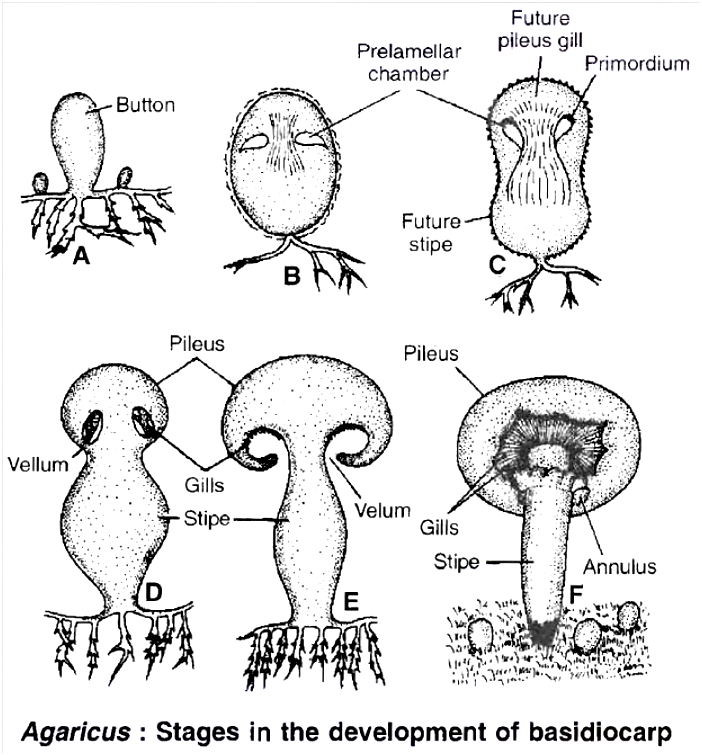
Under favourable conditions, hyphae of secondary mycelium collect at places and give rise to rounded or pyriform compact masses of hyphae called buttons.
The buttons enlarge and produce aerial fructifications or basidiocarps.
The latter are popularly termed as mushrooms. In contrast the secondary mycelium, from which mushrooms develop, is known as spawn.
The basidiocarps or mushrooms often lie in rings. The latter are called as fairy rings, its diameter increases centrifugally every year.
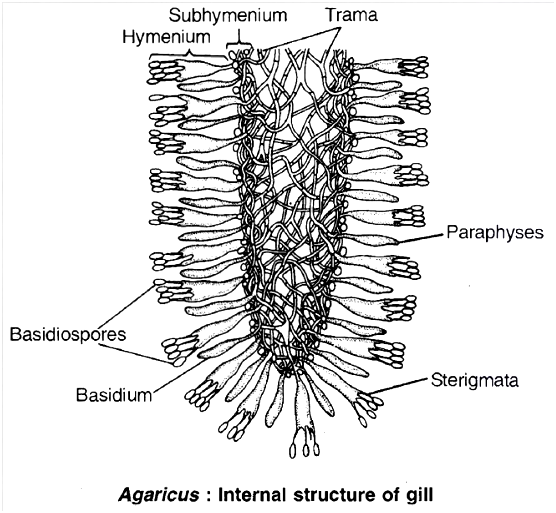
Each basidiocarp or mushroom is cream to pinkish brown in colour and consists of two parts, stipe and pileus.
The stipe or stalk is fleshy. It is slightly swollen at the base.
Pileus is umbrella-like cap of the mushroom. In the button stage, the pileus is connected to stipe by membrane called veil or velum.
It ruptures during growth of pileus. However, its remains can be seen on the upper part of stipe as annulus.
The pileus is circular in outline. Its upper surface is more or less convex. The under surface is flat or concave.
It bears 300-600 radiating rows of vertical plates named gills (lamellae).
The two sides of vertically placed gills are lined by thousands of club-shaped basidia alongwith sterile paraphyses.
The two, together constitute the fertile layer or hymenium of the gill. Hymenium is subtended by compact subhymenium.
The centre consists of interwoven hyphae called trama. Each basidium functions as the site for both karyogamy and meiosis. The two nuclei fuse to form a short-lived diploid synkaryon.
The latter, then divides meiotically giving rise to four haploid nuclei, two of (+) strain and two of (-) strain. The free end of the basidium now develops four peg-like outgrowths called sterigmata.
Each sterigmata bears an ovoid pinkish-purple meiospore termed as basidiospore. A droplet appears at the tip of sterigmata which creates tension and hanging basidiospores are carried away by air currents.
The basidiospores are liberated successively for several days. After falling on a suitable substratum, each basidiospore germinates to produce monokaryotic primary mycelium.
Life Cycle of Puccinia graminis tritici
P. graminis tritici is a macrocyclic (producing many dikaryotic spores), Heteroecious (requires more than one host i.e., primary host -wheat, secondary or alternate host -barberry).
It produces uredospores and teliospores on the wheat plant, basidiospores in soil and pycniospores and aeciospores on barberry.
It causes black or stem rust of wheat. Hence, we describe the various stages of life cycle on the basis of the host.
A. Stage of life cycle on wheat (primary host)
(i) Uredia and uredospores :
The dikaryotic aeciospores germinate on the leaves of wheat on both the surfaces and may also germinate on the stem.
They form the dikaryotic mycelium.
The germ tube protrudes out which swells up to form an elongated appressorium near the stomata.
A peg like outgrowth now arises from the appressorium and penetrates the stomata. It ramifies repeatedly to form a mass of mycelium this mycelium forms the uredospore.
As a result, some pressure is exerted on the epidermis which bursts exposing the uredospore. These clusters of uredospores have been variously referred to as uredosori or urediopustules.
A uredospore is reddish-brown, unicelled, oval or globose, stalked, dikaryotic spore. Its wall is three layered, the outer being somewhat spiny.
The uredial stage multiplies through the uredospores which germinate on fresh wheat plants (due to the red colour of spores this stage is called red rust stage).
(ii) Telia and teliospores (black rust stage) :
Towards the end of the season, the dikaryotic mycelium of the uredosorus begins to produce teliospores (or teleutospores) in the same sorus.
They are dark brown or black, stalked, thick walled, bi-celled spores. The upper cell is pointed, both the cells are binucleate.
The pustules containing teliospores are called as tella or teleutosori.
The teliospores also exert pressure on the epidermis which bursts open, exposing the spores.
It is at this stage the symptoms develop in stem also, so the disease is named black stem rust of wheat.
Karyogamy occurs inside each cell of teliospore and as a result they become diploid.
The teliospores cannot infect fresh wheat plants. They germinate in soil to form the basidiospores.
(iii) Basidia and basidiospores:
The two cells of the teliospores now act as hypobasidium. They germinate in soil and form a tube called promycelium.
The diploid nucleus migrates into epibasidium and then undergoes meiosis to form four haploid nuclei each of them develops as a basidiospore on the sterigmata.
Of these, two basidiospores belong to +ve strain and two to -ve strain.
These spores are not capable to infect a wheat plant. Each spore is unicelled, monokaryotic and unstalked.
These can infect the barberry plant (Berberis vulgaris) which is the secondary or alternate host occurring on the hills in India.
B. Stage of life cycle on barberry
(i) Spermatia or pycniospores
The basidiospores of both the strains (+ and -) can germinate on upper surface of barberry leaf.
They produce haplophase or primary mycelium of the respective strains which grows through the intercellular spaces.
Soon the mycelium forms a palisade like mat which organises like a flask shaped structure near the upper epidermis called as spermogonia or pycnidium.
They open by a single pore called ostiole.
The spermogonium is lined by palisade Ilike uninucleate cells called spermatiophores.
From the tips of spermatiophores are pinched off a large number of uninucleate cells called pycniospores or spermatia.
Besides, some sterile hyphae also arises which grow out through the ostiole.
They are called as periphysis.
In addition to these, some thin walled hyphae are also given out which become more elongated.
They are called as flexuous hyphae or receptive hyphae.
While the spermatia function as the male cells, the flexuous hyphae behave as the female hypha.
The pycniospores or spermatia protrude out of the ostiole in a nectar.
The insects feeding on this nectar transfer the spermatia from one spermogonium to the other.
Spermatization is brought about when spermatia of one strain come in contact with the trichogyne of flexuous hyphae of the other strain.
The nucleus of pycniospore or spermatium passes into the flexuous hyphae, thus bringing
(ii) Aecia and aeciospore :
An aecium or aeciosorus is produced on the lower surface of barberry leaves. It arises just beneath pycnium. The dikaryotized mycelium aggregates sub-epidermally.
This gives rise to a group of elongated dikaryotized cells which function as aecial mother cell. The mother cells differentiate a row of binucleate cells.
The alternate binucleate cells enlarge and they are identified as aeciospores. The alternate cell remaining small is disjunctor or sterile cell.
The sterile wall of the aecial cup called peridium or pseudoperianth presses the lower epidermis which eventually bursts open. Thus, the aeciospores are set free.
The aeciospores are polyhedral or ovate, binucleate, unicelled and double layered. The outer thick wall is called exine and the inner as intine.
They are set free in spring. They cannot infect the barberry bushes. These are carried from hills to the plains where they infect wheat plants. They germinate on the leaf surface from a germ tube which enters the host through stomata.

Annual Recurrence of Rust in India:
It was first studied by Prof. K.C. Mehta.
He concluded that, in India, the annual recurrence of rust on wheat takes place through uredospores.
The alternate host, Berberis vulgaris plays no role in our country. According to Mehta, if no wheat is grown on hills, the intensity of its infection in plains can be reduced.
He also suggested the involvement of certain collateral hosts like Briza minor, Bromus and Thalictrum for multiplication of uredospores during non-growing season of wheat.
V. Deuteromycetes: (The Fungi Imperfecti)
Deuteromycetes is an artificial class (form class) of fungi which has been created to include all those fungi in which sexual stage (or perfect stage) is not known (absent or not reported) .
The mycelium is septate and branched. Coenocytic forms are not known.
Asexual reproduction often occurs by conidia.
Once perfect (sexual) stages of members of Deuteromycetes were discovered they were often moved to Ascomycetes and Basidiomycetes but most members of Deuteromycetes are actually related to ascomycetes.
Some members are saprophytes or parasites while a large number of them are decomposers of litter and help in mineral cycling.
Concept Builder
(i) Leaf spot of rice : Helminthosporium oryzae causes leaf spot disease of rice commonly called brown leaf spot of rice. It caused Bengal famine in 1942-43.
(ii) Early blight: Alternaria solani causes early blight of potato. The leaves develop small oval brown spots with concentric rings (target board symptom).
(iii) Tikka disease : Circular necrotic dark brown or blackish leaf spots develop in groundnut due to Cercospora personata.
(iv) Red rot: Colletotrichum falcatum produces red rot of sugarcane.
(v) Wilts : Many economically important plants (e.g., cotton, pigeon pea) show sudden signs of wilting due to blockage of tracheary elements by growth of fungus, Fusarium especially F. oxysporum, F. udum.
(vi) Ringworm of foot/Athlete's foot is caused by Trichophyton interdigitate.
Common names of some fungi:
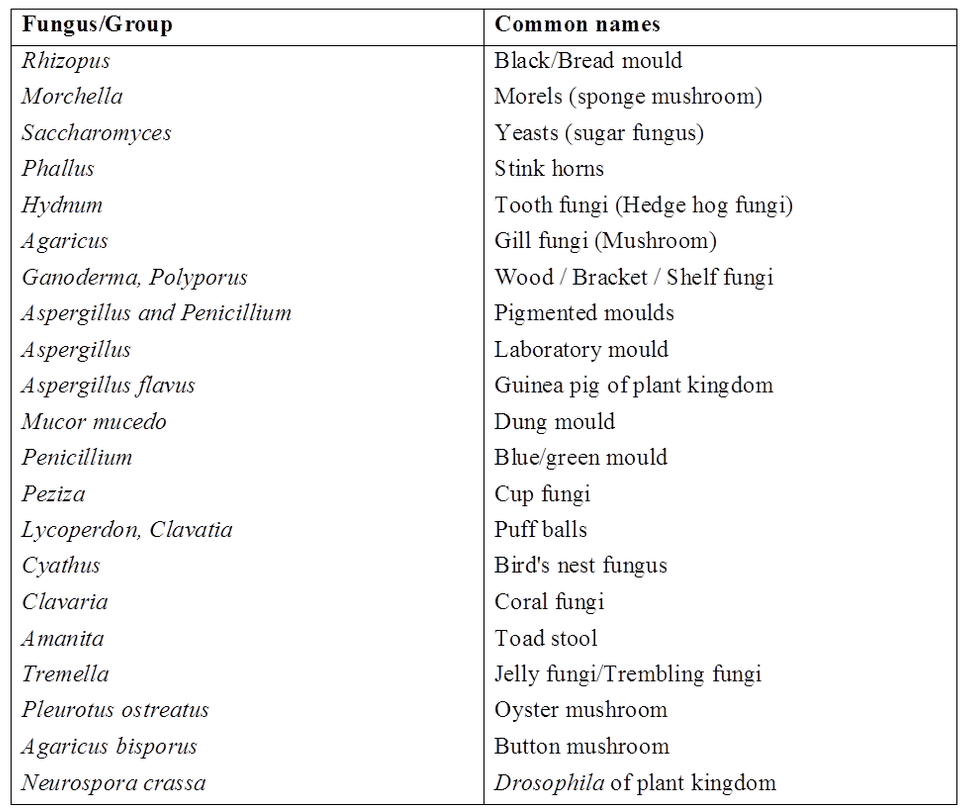
Concept Builder
Common Fungicides and their composition
- Bordeaux mixture – (CuSO4: Ca(OH)2 : H2O). First fungicide discovered by RMA Millardet Commonly known as holy water of plant pathology
- Burgandy mixture – Mixture of CuSO4 + Na2CO3 + H2O was discovered by Mass.
- Chestnut mixture – Ammonium carbonate + copper sulphate.
MYCORRHIZA (FUNGAL ROOTS)
The mutually beneficial or symbiotic association of a fungus with the roots of higher plants is termed mycorrhiza. Mycorrhizal roots differ in shape from normal roots and often show a wooly covering. These roots lack root cap and root hairs.
A fungus may get associated with roots of a number of plants and a particular plant may form association with a number of fungi. Depending upon the location of the fungus, the mycorrhiza is of two types, i.e., ectomycorrhiza and endomycorrhiza.
In ectomycorrhiza, the fungal hyphae are mainly external, forming a wooly covering on external surface of root and forms network of mycelium (Hartig net) in the intercellular spaces of the cortex. Fungal partner is commonly basidiomycetes, e.g., Pinus roots
In endomycorrhiza, the fungal hyphae enter the tissue of the root, spreading intercellularlly and intracellularly.
The fungus is able to break the cell wall in a limited way and is restricted to cortical region of the root. Some hyphae send small projections into cortical cells without destroying them.
Such fungi are termed VAM (Vesicular Arbuscular Mycorrhiza), e.g., Orchid roots.
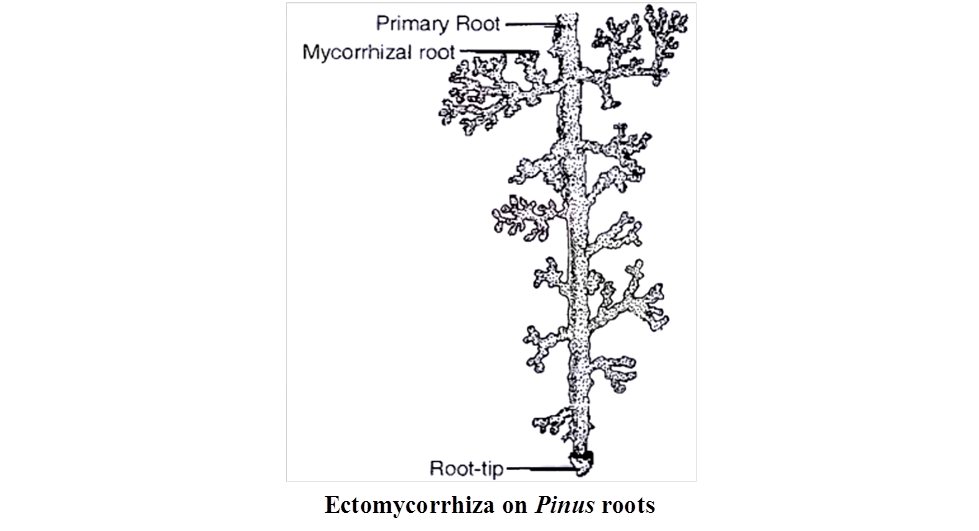
Mycorrhizal association is a symbiotic relationship as both the partners are mutually beneficial to each other. The fungal partner obtains nourishment from the cortical cells of the root and depends upon the plant for shelter.
The root cells excrete sugars and other soluble gradients which are used by fungal hyphae spreading in intercellular spaces. The hyphae may get nourishment from the cells directly and also by sending small projections into cortical cells.
The fungus seems to be essential for the growth of the plant having mycorrhiza.
The plant also gets benefit from the association as the fungal hyphae spreading in soil substantially increases the surface area of absorption, thereby enabling the plant to get enhanced supply of water, nitrogen, phosphorus and other minerals from the soil.
Orchids seldom occur without mycorrhiza. Certain forest trees like pines, birches show stunted growth if their roots are not associated with fungus.
LICHENS
Lichens are dual (composite) organisms or entities which contain a permanent association of a fungal partner or mycobiont and an algal partner or phycobiont.
Mycobiont is dominant partner and mostly belongs to ascomycetes (Ascolichens -, e.g., Graphis, CIadonia, Parmelia, Usnea, etc.) or sometimes basidiomycetes (Basidiolichens - e.g., Corella, Cora, etc.).
Phycobiont is mostly a member of Chlorophyceae (e.g., Chlorella, Trebouxia, Protococcus, Palmella, etc.) or can be a BGA (e.g., Nostoc, Chlorococcus, Scytonema, etc.).
The term lichen was coined by Theophrastus (370 -285 B.C.), also called Father of Botany.
Lichens often grow in most inhospitable and uninhabited places like barren rocks (saxicolous), soil (terricolous), icy tundra or alpines, sand dunes, roofs, walls, wood (Iignicolous), tree bark (corticolous), leaves, etc.
They commonly live under humid and exposed conditions but can tolerate extreme desiccation. However, lichens, cannot tolerate air pollution, especially due to sulphur dioxide (so are considered indicators of SO2 pollution).
Lichens are perennial. Their growth is slow. Lichens have greyish, yellowish, greenish, orange, dark brown or blackish colouration.
Structure
Based upon external morphology, the lichens are of three types :
(i) Crustose. Crust like, closely appressed to the substratum and attached to it at several places, e.g., Graphis, Lecanora, Rhizocarpon.
(ii) Foliose: The body of the lichen is flat, broad, lobed and leaf-like, which is attached to the substratum at one or a few places with the help of rhizoid like structures called rhizines, e.g., Parmelia, Peltigera.
(iii) Fruticose : The lichen is branched like a bush and attached to the substratum by means of a disc, e.g., CIadonia, Usnea, Evernia, Bryonia.
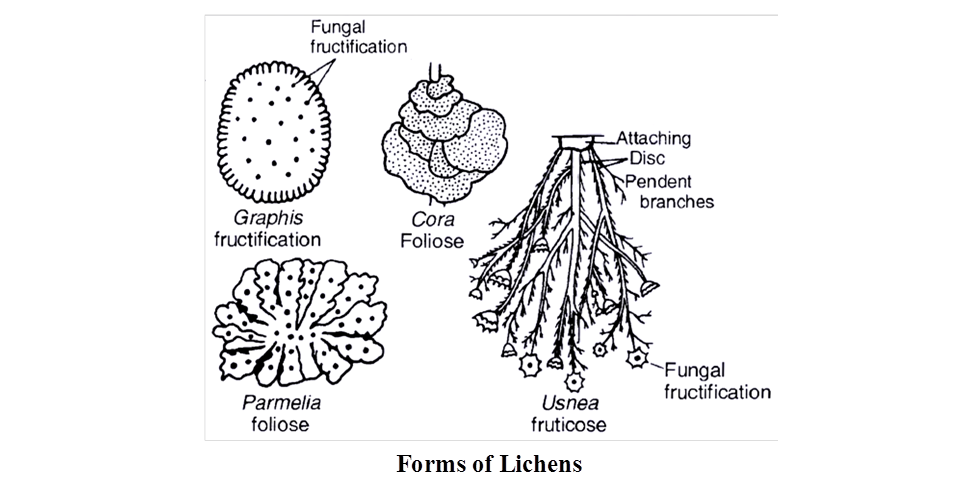
The bulk of lichen body is formed by fungal partner called mycobiont. It includes the surface, medulla (or interior) and rhizines (attaching devices).
The algal partner or phycobiont constitutes hardly 5% of the lichens body.
It is generally restricted to a narrow zone (algal zone) below the surface.
Relationship :
The fungus performs following functions:
Body structure and covering (ii) Anchoring (iii) Absorption of water and minerals. It can absorb water from wet air (atmosphere), dew and rain. Minerals are picked up both from substratum and atmosphere. Special chemicals are excreted by the fungal partner of the lichen to dissolve minerals from the substratum. (iv) Sex organs and fruitifications are of fungal origin.
The major function of alga is photosynthesis.
The cyanobacterial alga additionally takes part in nitrogen fixation. The alga picks up water and mineral salts from the fungus while the fungus obtains part of the food manufactured by the alga.
Therefore, in a lichen the association between alga and fungus is that of mutual benefit (mutualism) popularly called symbiosis.
However, at times the fungus is found to (i) send haustoria into algal cells (ii) induce alga to secrete organic substances and (iii) prevent alga to develop pectic covering. Therefore, some workers believe that the fungus is a controlled parasite over the alga. The phenomenon is called helotism.
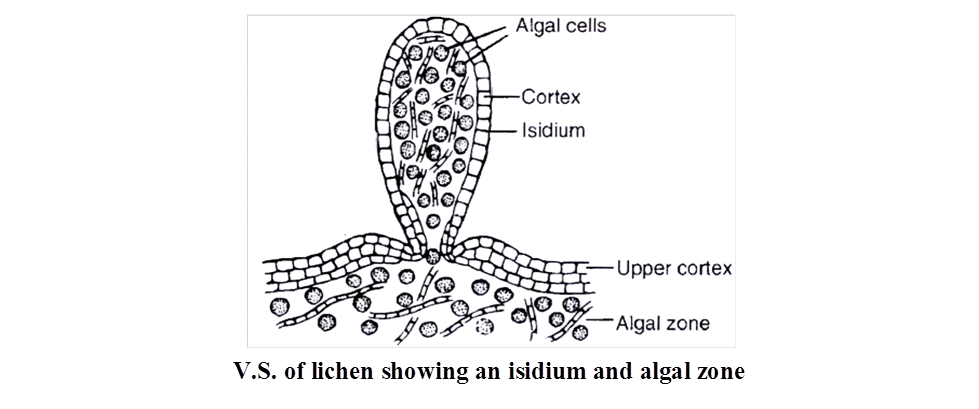
Reproduction: Lichens multiply by four methods:
(i) Progressive death and decay resulting in the separation of a lichen thallus into two or more parts.
(ii) Fragmentation caused by mechanical injury, due to wind or animal bites.
(iii) Isidia are superficial outgrowths of the lichens which are primarily meant for increasing surface area and photosynthetic activity. At time, they are broken off. Each isidium is capable of forming a new lichen because it has a core of a few algal cells surrounded by a sheath of fungal hyphae.
(iv) Soredia. These are most efficient means of asexual reproduction. They are microscopic lichen propagules which are produced in large numbers inside sori called pustules. Soredia are dispersed by air currents. After falling on a suitable substratum each soredium gives rise to a lichen, because it has a few algal cells surrounded incompletely by a weft of fungus.
Concept Builder
- Special structures in the thallus of lichen:
(i) Cyphellae help in exchange of gases, present in lower cortex.
(ii) Cephalodia help to retain moisture and its algal partner fix nitrogen also.
(iii) Breathing pores for aeration, present in upper cortex of thallus.
Early Colonisers : Lichens are early or pioneer colonisers of barren rocks, cliffs, mountains and new terrains. During their growth, lichens stick to the rocks and cliffs by secreting acids. It produces minute crevices where organic matter accumulates. It paves the way for growth of mosses.
Food: In tundra, Cladonia rangifera (Reindeer Moss) constitutes the staple food of reindeer, caribou, musk ox, etc. Cetraria islandica (Iceland Moss) is used as a food article in Iceland, Sweden and Norway Lecanora esculenta is regarded as bread of heaven by Jews. Parmelia (Rock Flower) is also a table delicacy Dermatocarpon miniatum (Stone Mushroom) is a vegetable in Japan.
Dyes : Orchil is obtained from Rocella tinctoria. The latter was also the source of litmus (R.montagnei) before the advent of synthetic products. Litmus is a pH indicator.
Perfumes: Scented incense is got from species of Ramalina and Evernia.
Medicines: Usnic acid got from Usnea (Old Man's Beard) and Cladonia has antibiotic properties. It is used in preparation of ointment for burns and wounds.
Air Pollution : Decrease in lichen population of an area is indicative of SO2 pollution.
Fires: In hot season, Usnea may produce forest fires.
VIRUS
Term virus was coined by Pasteur.
Viruses are obligate intracellular parasites. They are intermediate between living and non living entities.
Non living nature of virus
Lacking protoplast.
Ability to get crystallized, e.g., TMV, poliomyelitis virus.
Inability to live independent of a living cell. (Lack functional autonomy)
High specific gravity which is found only in non living objects
Absence of respiration.
Absence of energy storing system.
Absence of growth and division.
Living nature of virus
Being formed of organic macromolecules.
Presence of genetic material.
Ability to multiply.
Occurrence of mutations.
Occurrence of certain enzymes like, neuraminidase (first discovered), transcriptase and lysozyme in certain viruses.
Infectivity and host specificity.
Viruses can be 'killed' by autoclaving and ultraviolet rays.
They take over biosynthetic machinery of the host cell and produce chemicals required for their multiplication.
Viruses are responsible for a number of infectious disease like common cold, epidemic influenza, chicken pox, mumps, poliomyelitis, rabies, herpes, AIDS, SARS etc.
Concept Builder
Mayer described Tobacco Mosaic disease in 1886.
Iwanowsky is credited with the discovery of virus in 1892. TMV was the first virus to be discovered.
Beijerinck called virus as "Contagium vivum fluidum " (living infectious fluid).
In 1935, Stanley crystallised TMV.
Twort and d'Herelle discovered bacteriophage.
Lwoff and Wollmann discovered temperate viruses.
Shafferman and Morris discovered cyanophage, e.g., LPP-1.
Bawden and Pirie studied the chemical nature (nucleoproteins) of TMV.
Sinsheimer discovered single stranded DNA in bacteriophage f × 174
Issac and Lindemann discovered interferon
Delbruck (1938), found viruses to undergo mutations.
Reverse transcription in Retroviruses was discovered by Temin and Baltimore, so the phenomenon is called teminism. The enzyme reverse transcriptase is RNA dependent DNA polymerase.
Structural Components of Viruses
(i) Envelope is the outer thin loose covering composed of proteins (from virus), lipids and carbohydrates (both from host). It has smaller subunits known as peplomers, e.g., Herpes virus, HIV, Vaccinia virus etc. If it is not present the virus is said to be naked.
(ii) Capsid : It is the outer protein coat made up of subunits called capsomeres, their number is virus specific. These possess antigenic properties.
(iii) Nucleoid : Viruses contain either DNA or RNA. No virus contains both DNA and RNA.
(a) DNA containing viruses are called deoxyviruses.
These are of two types:
(i) Double stranded DNA (dsDNA) virus, e.g., Pox virus, Cauliflower mosaic virus.
(ii) Single stranded DNA (ssDNA) virus, e.g., Coliphage ×174, M 13 phage.
(b) RNA containing viruses or riboviruses are of two types.
(i) Double stranded RNA (ds RNA) virus, e.g., Reo virus, Wound Tumour Virus.
(ii) Single stranded RNA (ss RNA) virus, e.g., TMV, Influenza virus, Foot and Mouth disease virus, Retroviruses (HIV).
Classification of Virus
Holmes (1948) has divided viruses into three groups on the basis of specific hosts.
(a) Phytophagineae are plant viruses. They generally have ssRNA, e.g., TMV, Potato Mosaic Virus, Yellow Vein Mosaic virus, Cauliflower Mosaic virus.
(b) Zoophagineae are animal viruses. They commonly have ssRNA or dsRNA or dsDNA. e.g., Poliomyelitis virus, Influenza viruses, Small pox virus, Mumps virus, Rabies virus.
(c) Phagineae attack lower organisms
(i) Bacteriophages are bacterial viruses and they usually possess dsDNA, e.g., T2, T4, lambda ![]() phage.
phage.
(ii) Coliphages are viruses of E.coli, e.g., Coliphage fd.
(iii) Cyanophages attack blue green algae, e.g., LPP-1, SM-1 .
(iv) Phycophages attack algae.
(v) Mycophages attack fungi.
(vi) Zymophages attack yeast.
Reproduction
It is of two main types: Phagic and Pinocytic
(a) Phagic Reproduction : It is further of two types :
(i) Lytic cycle : Occurs in virulent phages, e.g., T4 bacteriophages.
(ii) Lysogenic cycle : Occurs in temperate viruses such as phage.
(b) Pinocytic Reproduction: It is found in viruses like TMV, HIV, Hepatitis B etc., in which whole of virus particle enters host cell except envelope (if present).
Structural details of some viruses
(1) Tobacco Mosaic Virus (TMV) is elongated rod like, 3000 Å long, 180 Å in diameter with molecular weight Protein 39.4 × 106 dalton. 2130 capsomeres are arranged helically to form the capsid. RNA strand is helical. ssRNA consists of 6400 nucleotides. Thus, the ratio of nucleotides : capsomeres = 3 : 1
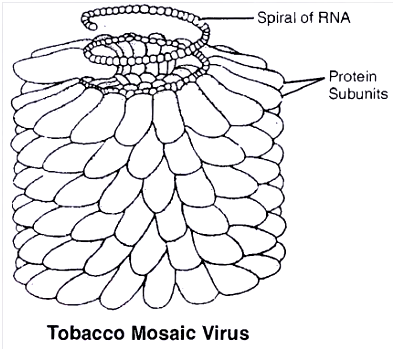
(2) Pox virus / variola is the causal agent of small pox. These are among the largest of animal viruses, are rectangular (brick shaped), 300 × 230 nm in size. Genome is dumbell shaped with central core of dsDNA. The core has two enzymes RNA polymerase and ATP phosphohydrolase.
(3) AIDS virus consists of single stranded RNA. It has 2 copies of ssRNA. Outer cover has 5 layers, i.e., outer most glycoprotein, followed by double lipid layer and the innermost has two protein layers.
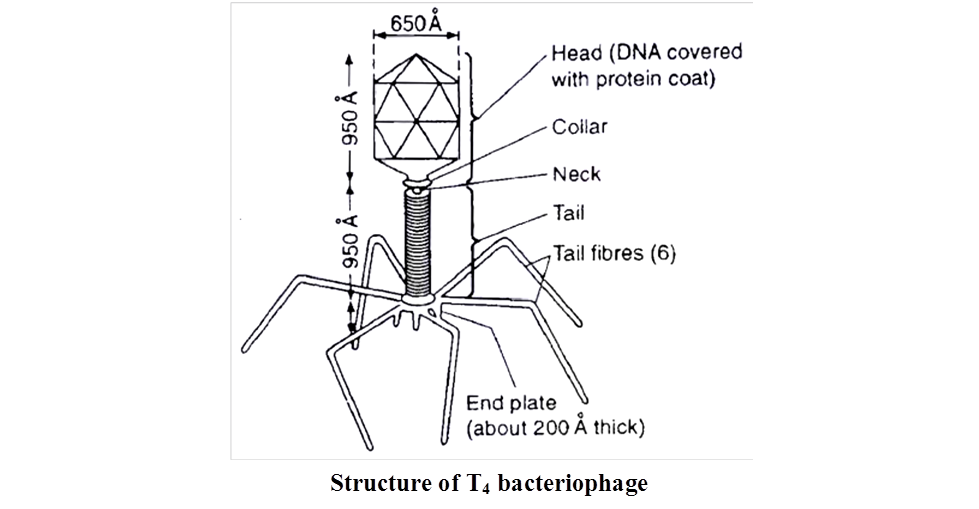
T4 Bacteriophage has a tadpole like structure with polyhedral head connected to a helical tail (binal). The head consists of nucleic acid surrounded by a protein coat or capsid. Nucleic acid is double stranded DNA. Tail is proteinaceous tube-like, core surrounded by sheath. At one end, tube is joined to the head by thin collar. At the other end, it has a hexagonal base plate with six small tail pins and six tail fibres which help in attachment of the phage to the host cell.
- Sub Viral Agents: These are viruses which lack one of the essential component, e.g., viroids, virusoids, prions
- Viroids (L. virus -poison, eidos -diminutive)
- They are the smallest self replicating particles which were discovered by Diener (1971). Viroids are infectious RNA particles which are devoid of protein coat.
- They are obligate parasites. Molecular weight of a viroid is low.
- The RNA is tightly folded to form circular or linear structures. Viroids are known to cause diseases (some 20) in plants only, e.g., Potato spindle tuber disease (PSTD), Chrysanthemum stunt and Citrus exocortis.
(2) Virusoids
- Discovered by Randle et. al., these are RNA viruses but inside the capsid of other larger virus. They replicate within the host and do not cause any infection.
(3) Prions
Discovered by Alper et al.
Proteinaceous infectious particles, causing certain diseases like
(i) Kuru disease (laughing death disease in humans)
(ii) Bovine spongiform encephalopathy (BSE or Mad cow disease)
(iii) Scrapie disease in sheep
(iv) Creutz Feldt Jakob disease
Table 5 : Viral diseases of Plants

Table 6 : Viral diseases of Man
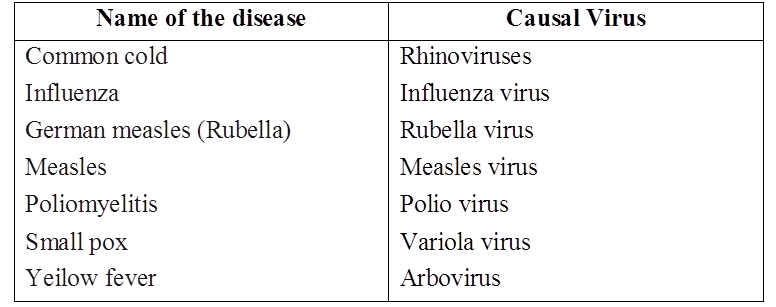
Animal viral diseases -Foot and mouth disease, Rinderpest, Ranikhet, Bird flu etc.
Concept Builder
Nomenclature of viruses :
International committee of virus nomenclature has given a system of naming the virus. The system consists of two parts. First part is common name of the virus and second part has the coded information about the virus. This is called as Cryptogram.
Kingdom: Fungi
Kingdom Fungi
Fungi are eukaryotic organisms that include yeasts, molds, mushrooms as well as other microbes.Fungi are a distinct kingdom of heterotrophic creatures. They have a wide range of forms and environments. Fungi can often be observed on stale bread and rotten fruits. Toadstools and the common mushroom that we eat are both fungi. A parasitic fungus causes white patches on mustard leaves. Some unicellular fungi, such as yeast, are utilized in the production of bread and beer. Other fungi produce illnesses in plants and animals; Puccinia, which causes wheat rust, is a good example. Penicillium, for example, is a source of antibiotics. Fungi are widely distributed and can be found in the air, water, soil, and on animals and plants. They thrive in warm, humid environments.Mycology is the branch of biology concerned with the study of fungi.
Fungi are filamentous, with the exception of yeasts, which are unicellular. Their bodies are made up of hyphae, which are long, slender thread-like structures. Mycelium refers to the network of hyphae. Coenocytic hyphae are hyphae that are continuous tubes filled with multinucleated cytoplasm. In the hyphae of others, there are septae or cross walls. Fungi's cell walls are made up of chitin and carbohydrates.
Saprophytes are fungi that are heterotrophic and absorb soluble organic materials from dead substrates. Parasites are organisms that rely on live plants and animals for their survival. They can also live as symbionts, forming lichens with algae and mycorrhiza with the roots of higher plants.
Fungi reproduce via vegetative processes such as fragmentation, fission, and budding. Spores known as conidia, sporangiospores, and zoospores are instrumental in asexual reproduction, while oospores, ascospores, and basidiospores are responsible for sexual reproduction. Fruiting bodies are structures that produce different types of spores.
The three phases of the sexual cycle are as follows:
(i) Plasmogamy, which is the fusion of protoplasms between two motile or non-motile gametes.
(ii) Karyogamy, which is the fusion of two nuclei.
(iii) In a zygote, meiosis results in haploid spores.
Two haploid hyphae of compatible mating types come together and merge when a fungus reproduces sexually. In some fungi, the fusing of two haploid cells results in the formation of diploid cells right away (2n).
Kingdom fungi can be divided into three groups based on their nutritional needs.
(i)Saprophytic fungus get their sustenance from dead organic matter. Rhizopus, Penicillium, and Aspergillus are other examples.
(ii)Parasitic fungus get their food by living on other living organisms (plants or animals) and absorbing nutrients from them. Taphrina and Puccinia are two examples.
(iii)Symbiotic fungi are those that exist in an interdependent relationship with other species in which both parties benefit. Lichens and mycorrhizae are two examples. Lichens are the result of a symbiotic relationship between algae and fungi. Algae and fungi benefit from each other in this situation because fungi give protection to algae and algae provide carbohydrates for fungi.
The morphology of the mycelium, mode of sporeformation, and fruiting bodies form the basis for thedivision of the kingdom into various classes which are discussed below.
(a) Phycomycetes:
Phycomycetes can be found in aquatic areas and on decaying wood in moist and humid environments, as well as obligatory parasites on plants. Algal fungi are sometimes known as Phycomycetes. They have aseptate coenocytic hyphae that are distinctive. Asexual reproduction occurs via zoospores (motile) or aplanospores (asexual) (non-motile). In the sporangium, these spores are produced endogenously. A zygospore is created when two gametes fuse together. The morphology of these gametes is either similar (isogamous) or distinct (heterogamous) (anisogamous or oogamous). Mucor, Rhizopus (the bread mold), and Albugo(the parasitic fungi on mustard) are other typical examples.
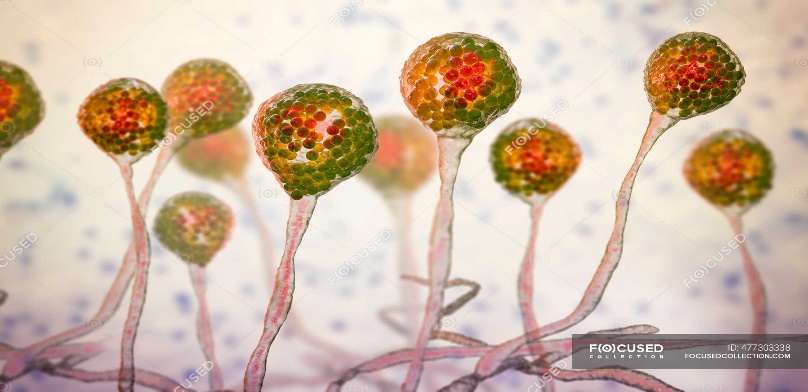
(b) Ascomycetes:
The ascomycetes, sometimes known as sac-fungi, are typically multicellular (e.g., Penicillium) or occasionally unicellular (e.g. Saccharomyces or yeast). These fungi may be Saprophytic, decomposers, parasitic, or coprophilous(growing on dung). Mycelium is septate and branched. Conidia grown exogenously on special mycelium termed conidiophores are the asexual spores. Conidia create mycelium when they germinate. Ascospores are sexual spores that are produced endogenously in sacs similar to asci (singular ascus). These asci are grouped in ascocarps, which are distinct types of fruiting structures. Aspergillus, Claviceps, and Neurospora are some examples. Neurospora is widely utilized in biochemical and genetic research. Many of the members, such as morels and truffles, are edible and regarded as delicacies.
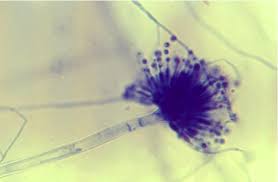
(c) Basidiomycetes:
Mushrooms, bracket fungi, and puffballs are examples of basidiomycetes. They can be found growing in soil, on logs and tree stumps, and in living things. Rusts and smuts, for example, are parasitic plant bodies. The mycelium is septate and branching. Although asexual spores are rare, vegetative reproduction by fragmentation is prevalent. Although there are no sex organs, plasmogamy is caused by the fusing of two vegetative or somatic cells of different strains or genotypes. The dikaryotic complex that results eventually gives rise to basidium. The basidium undergoes karyogamy and meiosis, resulting in four basidiospores. The basidiospores are formed exogenously on the basidium (pl.: basidia). Basidia are arranged in basidiocarps, which are fruiting bodies. Agaricus (mushroom), Ustilago (smut), and Puccinia are some of the most prevalent members.
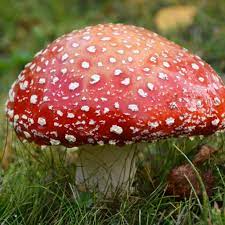
(d) Deuteromycetes:
In this category, only asexual or vegetative phases of these fungi are known, therefore they are commonly referred to as imperfect fungi. When the sexual forms of these fungi were discovered, they were placed in the appropriate groups. It's also likely that the asexual and vegetative stages were given one name (and were classified as Deuteromycetes), while the sexual stage was given another one (and placed under another class). The fungi were accurately recognized and moved out of Deuteromycetes after the links were discovered. Deuteromycetes were frequently shifted to ascomycetes and basidiomycetes after their perfect (sexual) stages were discovered. Conidia are asexual spores that Deuteromycetes use to reproduce. The mycelium is branching and septate.Some individuals are saprophytes or parasites, whereas the majority are litter decomposers who aid in mineral cycling. Alternaria, Colletotrichum, and Trichoderma are other examples.
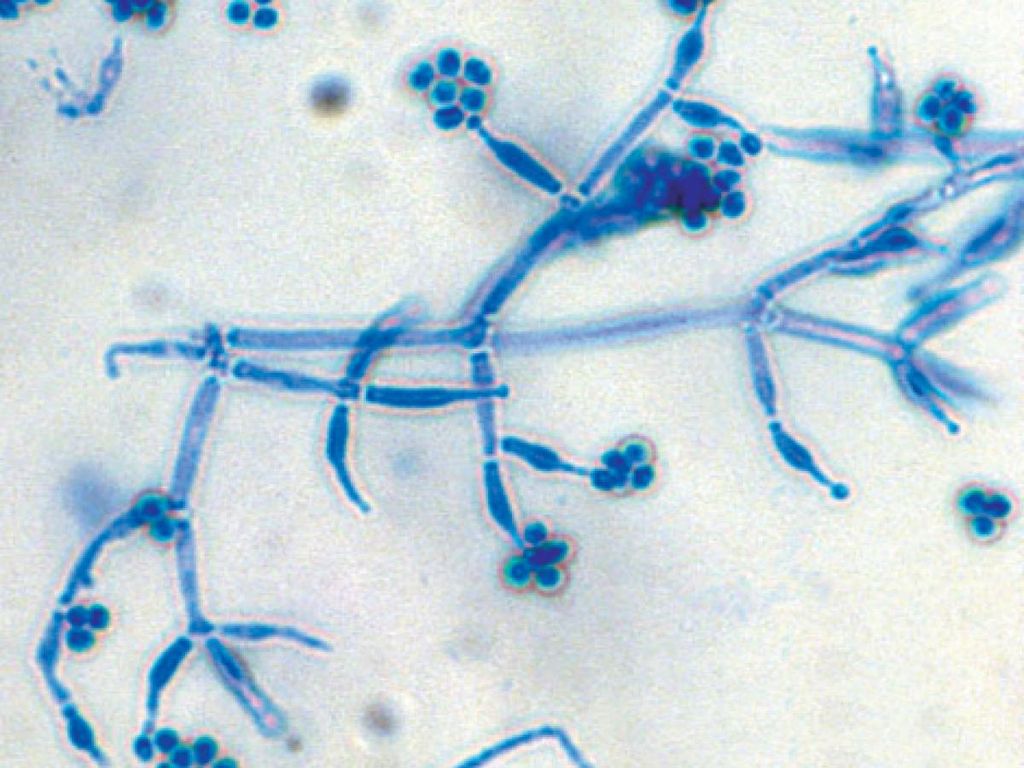
Kingdom: Plantae
- Books Name
- ACME SMART COACHING Biology Book
- Publication
- ACME SMART PUBLICATION
- Course
- CBSE Class 11
- Subject
- Biology
KINGDOM PLANTAE
Members of Plant Kingdom are multicellular, eukaryotic, photosynthetic organisms.
Main characters of the members of this kingdom are:
Cellulosic cell wall.
Non-motile, excepts some aquatic forms.
Presence of chloroplasts.
Photosynthetic mode of nutrition (oxygenic photosynthesis), e.g., different types of algae (green, brown, red algae), bryophytes, pteridophytes, gymnosperms and angiosperms.
Growth is usually indefinite.
Some of the plants are heterotrophic. They are mostly parasitic. A few are saprobes.
small group of autotrophic plants catch small animals and insects for obtaining nitrogen.They are called carnivorous or insectivorous plants.
Reproduction is both asexual and sexual. Accessory spores are present in lower plants.
An embryo stage is absent in the algal group but present in others.

Kingdom: Plantae
Kingdom Plantae
Kingdom Plantae refers to any eukaryotic chlorophyll-containing organism that is typically referred to as a plant. Plant cells are eukaryotic in nature, with significant chloroplasts and a cellulose-based cell wall. Algae, bryophytes, Pteridophytes, gymnosperms, and angiosperms are all members of the Plantae family. A few members, such as insectivorous plants and parasites, are partially heterotrophic.
Insectivorous plants include bladderwort and Venus flytrap, while Cuscutaexists like a parasite.
Plants have two unique phases in their life cycle: diploid sporophytic and haploid gametophytic, which alternate. The lengths of the haploid and diploid phases, as well as whether they are free-living or dependent on others, varied between plant families. Alternation of generation is the term for this phenomenon.
Plants are classified according to the following criteria:
1. Plant body: Whether or not a well-differentiated plant body exists. Root, stem, and leaves, for example.
2. Vascular system: The presence or absence of a vascular system for water and other material movements. Phloem and Xylem, are two types of vascular tissues in plants.
3. The presence or absence of flowers and seeds, as well as whether the seeds are bare or wrapped in fruit, are all factors in seed production.
According to the above-mentioned criteria, the plant kingdom has been divided into five subgroups:
(A) Thallophyta:
Thallophytes have a thallus-like body structure and lack a well-differentiated body structure. Plants having a primitive and simple body structure are included. The thallus is the plant's main body, and it can be filamentous, colonial, branching, or unbranched. Algae such as green algae, red algae, and brown algae are examples. Volvox, Fucus, Spirogyra, Chara, Polysiphonia, Ulothrix, and other species are common examples.
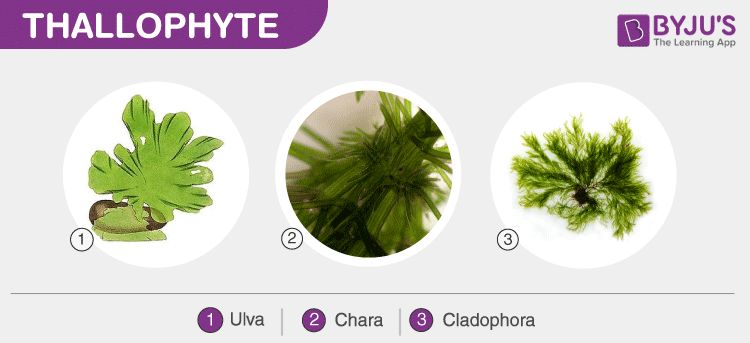
(B) Bryophytes
Bryophytes are plants that lack vascular tissues. Root-like, stem-like, and leaf-like components make up the plant's body. Bryophytes are terrestrial plants that are also known as "plant amphibians" since they require water for sexual reproduction. They thrive in wet, shaded environments. Mosses, hornworts, and liverworts are all members of the Bryophyta family. Marchantia, Funaria, Sphagnum, Antheoceros, etc. are well-known examples.
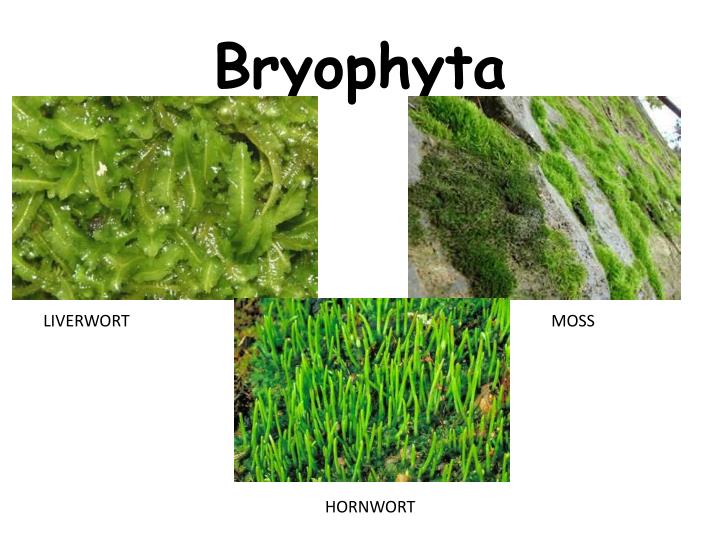
(C) Pteridophyta:
Pteridophytes have a plant body that is well-differentiated into roots, stems, and leaves. They have a circulatory system that allows water and other chemicals to be transported. Selaginella, Equisetum, Pteris, and other common examples are only a few.
Non-flowering and non-seed bearing plants. E.g. Thallophyta, Bryophyta, Pteridophyta are collectively known as Cryptogams.
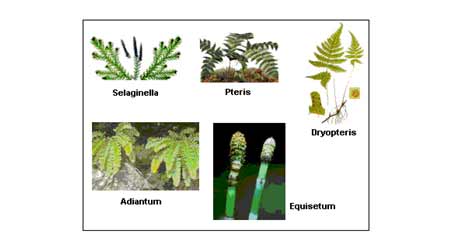
(D) Gymnosperms:
Gymnosperms have a plant body and vascular tissues that are well-differentiated. They produce naked seeds, which are seeds that are not encased in a fruit. Gymnosperms include plants such as Cycas, Pinus, Ephedra, and others.
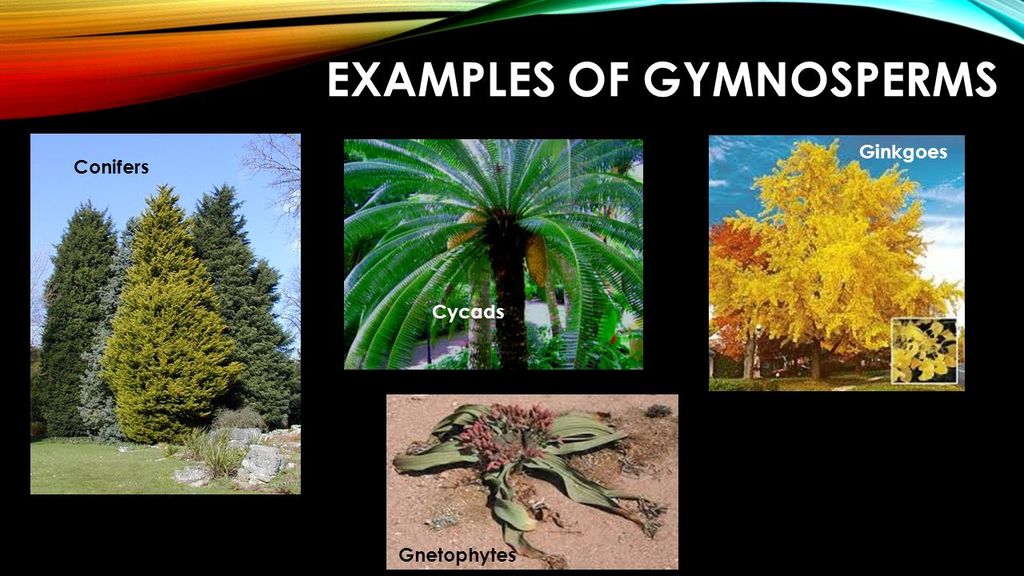
(E) Angiosperms:
Seed-bearing vascular plants with a well-differentiated plant body are known as angiosperms. Angiosperm seeds are contained within the fruits. Angiosperms are found all over the world and range in size from 0.1 cm to 100 m. For example, Wolffia is a little plant that grows to be around 0.1 cm tall, while Eucalyptus trees grow to be over 100 m tall. According to the number of cotyledons contained in the seeds, angiosperms are further split into monocotyledons and dicotyledons. Mango, rose, tomato, onion, wheat, maize, and other common examples are only a few.
Flowering and seed-bearing plants. E.g. Gymnosperms, Angiosperms are known as Phanerogams.
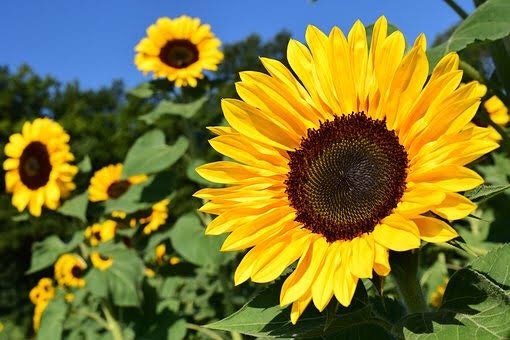
Kingdom: Animalia
- Books Name
- ACME SMART COACHING Biology Book
- Publication
- ACME SMART PUBLICATION
- Course
- CBSE Class 11
- Subject
- Biology
KINGDOM ANIMALIA
These are multicellular eukaryotic organisms.
The cells do not contain cell wall but contain only cell membrane.
They do not perform photosynthesis and have heterotrophic nutrition.
They have the power of locomotion.
They show increased sensitivity through the nervous system
Kingdom: Animalia
Kingdom Animalia
Multicellular eukaryotic organisms characterize this kingdom. Animals rely on plants for food, either directly or indirectly. Food is digested in an interior cavity, and food reserves are stored as glycogen or fat. Their feeding mode is heterotrophic and holozoic. They have a distinct growth pattern and mature into adults with distinct shapes and sizes. Higher forms have more complex sensory and motor mechanisms. The majority of them can move around. Male and female copulation is followed by embryological development in sexual reproduction. The animal kingdom is the most populous of the five kingdoms. They do not, however, have chlorophyll or a cell wall, as do plants.
Kingdom Animalia is divided into ten subphyla depending on body design or differentiation. These phyla are as follows:
(A) Phylum Porifera:
It is a phylum of organisms that have holes or perforations. Commonly known as Sponges. Poriferans are multicellular organisms with a hard outer skeleton that is non-motile. Their bodies have pores that form a canal system that aids in the passage of chemicals. They lack a well-developed organ or organ system and are not distinguished between head and tail. They primarily live in a marine environment. Spongilla and Sycon are examples of the Porifera phylum.
(B) Phylum Coelenterata (Cnidaria):
Hollow-bellied organisms are included in coelenterates. The presence of a hollow bodily cavity is one of the distinguishing characteristics of this group. The body is made up of two layers of cells: interior and exterior linings, which are differentiated into two ends. All aquatic animals are included in this phyla. Members of this phylum dwell in both colonies (corals) and solitary environments (Sea anemones). Hydra and jellyfish are examples of the phylum Coelenterata.
(C) Phylum Platyhelminthes:
Flatworms are the popular name for Platyhelminthes. Their body shape is complicated, dorsoventrally flattened, and distinct. Tissues are triploblastic and differentiated from three layers of cells. There is no actual interior cavity or coelom in them. They are symmetrical on both sides and can be free-living (Planaria) or parasitic (liver flukes). Tapeworm and Planaria are examples of Platyhelminthes phylum.
(D) Phylum Nematoda:
Nematodes, sometimes known as roundworms, belong to the Phylum Nematoda. The body of a nematode is cylindrical. They are triploblastic and bilaterally symmetrical. They have a fake bodily cavity called pseudocoelom. Elephantiasis and ascariasis are parasitic diseases caused by them. Ascaris and Wuchereria are examples of the phylum Nematoda.
(E) Phylum Annelida:
Annelids, are often known as segmented or ringed worms. They possess a head and tail that are separated by a segmented cylindrical body. The body is symmetrical on both sides and is triploblastic. They have a true cavity in their bodies. Their habitat includes both marine and freshwater environments, as well as land. Earthworms and Leeches are examples of the phylum Annelida.
(F) Phylum Arthropoda:
The term "arthropod" refers to a creature with jointed legs. This phylum includes animals with jointed appendages. This is the animal kingdom's largest phylum. They have jointed legs, an exoskeleton, and a segmented body that is bilaterally symmetrical. Organs and organ systems are well-differentiated. They have an open circulatory system, but no distinct blood vessels. Spiders, butterflies, and mosquitoes are all members of the Arthropoda phylum.
(G) Phylum Mollusca:
Molluscs are a wide group of animals that belong to the Phylum Mollusca. They are triploblastic and bilaterally symmetrical. The body is less segmented, yet organs and organ systems are well-developed. Mollusks typically have an open circulatory system. There are limbs present. Snails and octopuses are examples of the Mollusca phylum.
(H) Phylum Echinodermata:
Echinoderms are animals with spiky skin. They are triploblastic and have radial symmetry. They are true coelomates. The skeletal structure is made up of calcium carbonate and is quite hard. They are aquatic animals that live in the open ocean. Sea urchins and starfish are examples of the phylum Echinodermata.
(I) Phylum Hemichordata:
Hemichordata is a phylum of marine deuterostome organisms that is sometimes referred to as the echinoderms' sister group. The body is soft and delicate, with a proboscis. The epidermis is made up of only one layer. It is made up of worm-like marine invertebrates that are organized into organ systems. They have a circulatory system that is open. Because they are marine, they breathe through their gills. External fertilization is observed, and they have different sexes. Development is a direct process. Hemichordata includes Balanoglossus and Saccoglossus.
(J) Phylum Chordata:
Animals having a flexible cord supporting their dorsal or rear sides belong to the Chordata phylum. The majority of the species in the phylum Chordata are vertebrates or creatures with backbones. They are bilaterally symmetrical, triploblastic, and classified at the organ-system level. They have a nerve cord and a notochord. The circulatory system is one that is closed. Urochordata, Cephalochordata, and Vertebrata are the three subphyla of Chordata. Chordates include pandas, crows, sharks, salamanders, alligators, sea squirts, and many others.
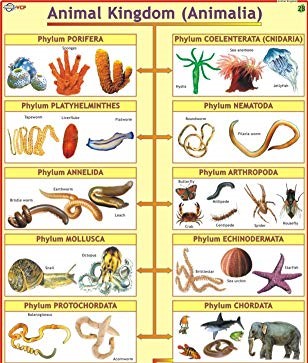
Viruses, viroids, prions and lichens:
Lichens and some acellular species like viruses, viroids, and prions are not included in Whittaker's five kingdom classification system. Here's a quick run-down of what they're all about.
Viruses were not classified since they are not actually 'alive,' as defined by organisms with a cell structure. Viruses are non-cellular organisms with a crystalline structure that is inactive outside of living cells. When they infect a cell, they use the host cell's machinery to duplicate themselves, eventually destroying the host. Viruses are classified as either living or non-living organisms. Dmitri Ivanowsky (1892), who identified specific bacteria as the causal organisms of the mosaic sickness, gave the name virus, which means venom or deadly fluid.Because they passed through bacterium-proof filters, they were discovered to be smaller than bacteria. M.W. Beijerinek (1898) discovered that an extract from sick tobacco plants could infect healthy plants, and he named the fluid Contagium vivum fluidum (infectious living fluid). W.M. Stanley (1935) demonstrated that viruses can crystallize, and that crystals are mostly made up of proteins. Outside of their respective host cell, they are inactive. Viruses are obligate parasites.Viruses include genetic material in the form of RNA or DNA, in addition to proteins. There isn't a single virus that has both RNA and DNA. A virus is a nucleoprotein with infectious genetic material. Plant viruses contain single-stranded RNA, while animal viruses have either single or double-stranded RNA or double-stranded DNA.
Bacterial viruses, also known as bacteriophages (viruses that infect bacteria), are double-stranded DNA viruses that infect bacteria. The nucleic acid is protected by a protein coat called capsid, which is made up of tiny subunits called capsomeres. The geometric forms of these capsomeres are helical or polyhedral. Mumps, smallpox, herpes, and influenza are all diseases caused by viruses. AIDS is also caused by a virus known as HIV in humans.Mosaic formation, leaf rolling and curling, yellowing and vein clearing, dwarfing, and stunted development are some of the symptoms seen in plants.
Viroids: In 1971, T.O. Diener found a novel infectious agent that caused potato spindle tuber disease and was smaller than viruses. It was discovered to be a free RNA that lacked the protein covering that viruses have, therefore the term viroid. The viroid's RNA has a low molecular weight.
Prions: In modern medicine, an agent made up of improperly folded protein has been discovered to spread some infectious brain illnesses. The agent was about the same size as viruses. Prions were the name given to these agents. The most well-known prions disorders are bovine spongiform encephalopathy (BSE), also known as mad cow disease in cattle, and its human counterpart Cr–Jacob disease (CJD).
Lichens are symbiotic (meaning mutually beneficial) interactions between algae and fungi. Phycobiont refers to the algal component, while mycobiont refers to the fungus component. Both are autotrophic and heterotrophic, respectively. Fungi offer refuge and absorb mineral nutrients and water for algae, and algae supply sustenance for fungi. Their relationship is so strong that if you saw a lichen in the wild, you'd never guess it included two different organisms. Lichens are excellent pollutant indicators since they do not develop in polluted environments.
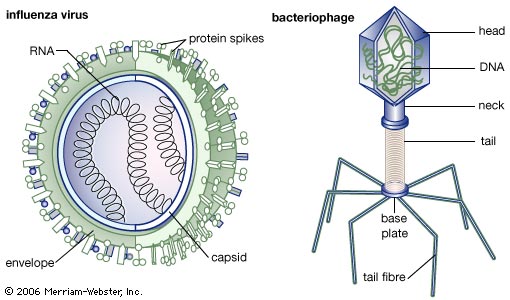

 ACME SMART PUBLICATION
ACME SMART PUBLICATION
